One of the important, albeit smaller, structures within the National Museum Bangkok is the Red House.
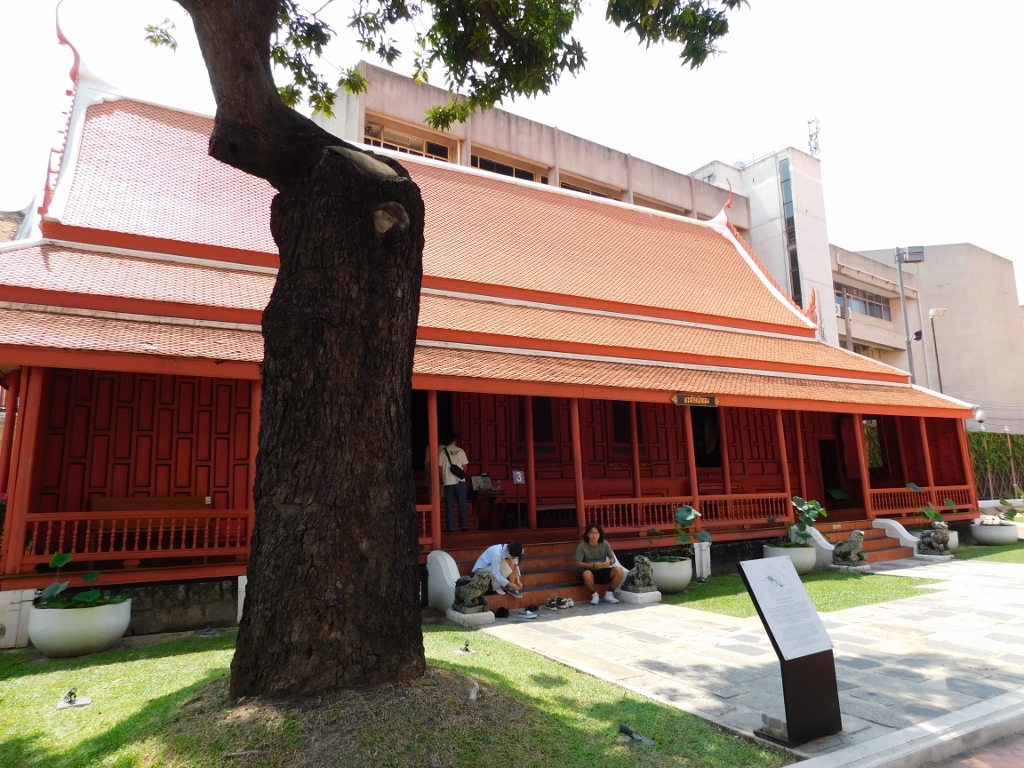 Red House within the National Museum Bangkok
Red House within the National Museum Bangkok
However, before entering the Red House, it was interesting for me to see a mango tree growing here. In 1905, the son of one of the museum employees planted a mango seed from which this impressive tree, still visible today, grew.
The Red House was originally located within the Grand Palace complex, built by King Rama I for his older sister. The house was later moved several times and eventually ended up here, becoming part of the National Museum. To explore this part of the museum, visitors are required to take off their shoes.
Inside, various exhibits from the early 20th century are on display.
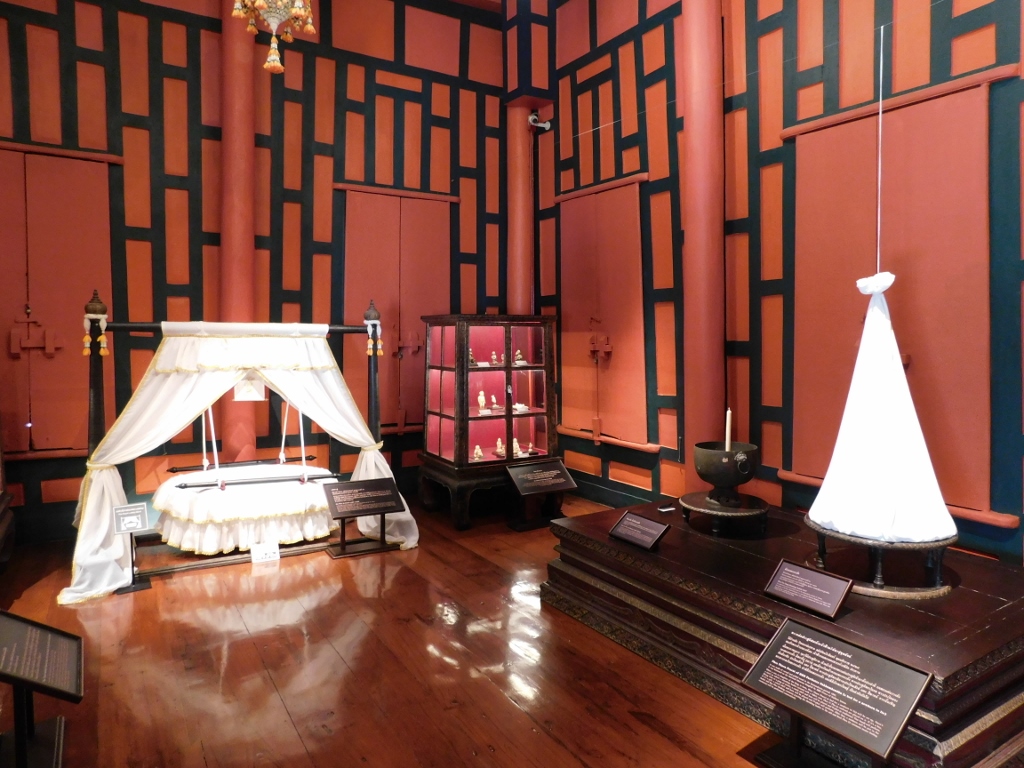 The National Museum Bangkok, a detail
The National Museum Bangkok, a detail
Next, I went out into the courtyard and first took photos of one of the pavilions that are a part of the National Museum, representing an example of traditional Thai architecture. Moreover, it’s a good spot to sit in the shade and rest a little.
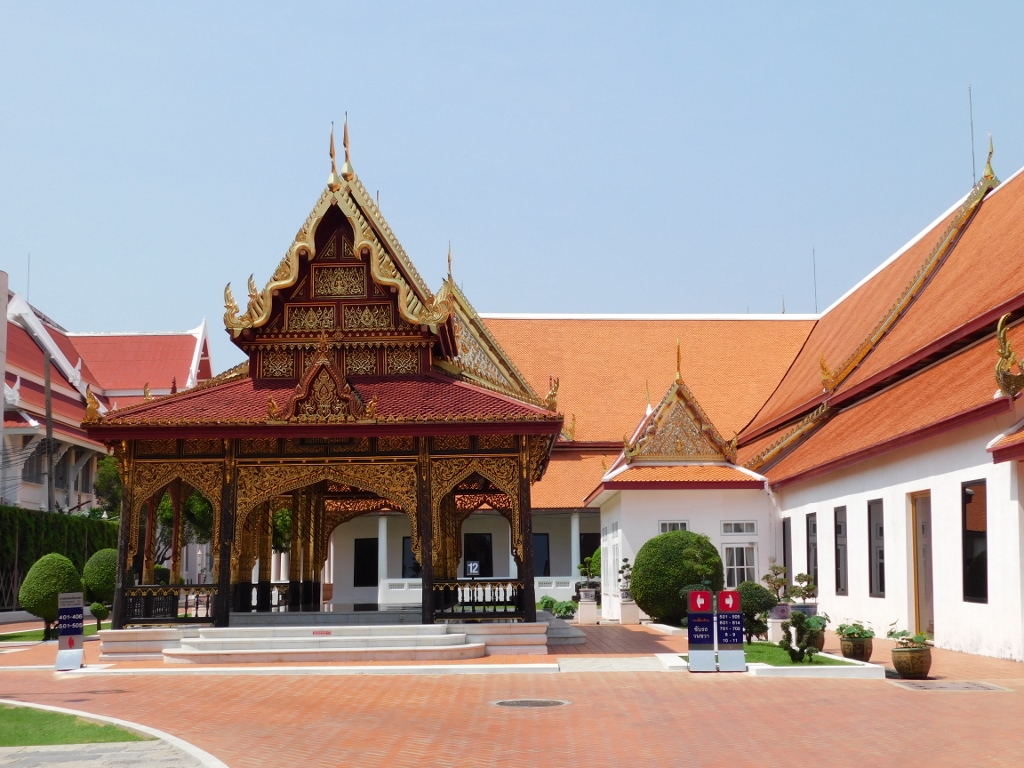 The National Museum Bangkok, a detail
The National Museum Bangkok, a detail
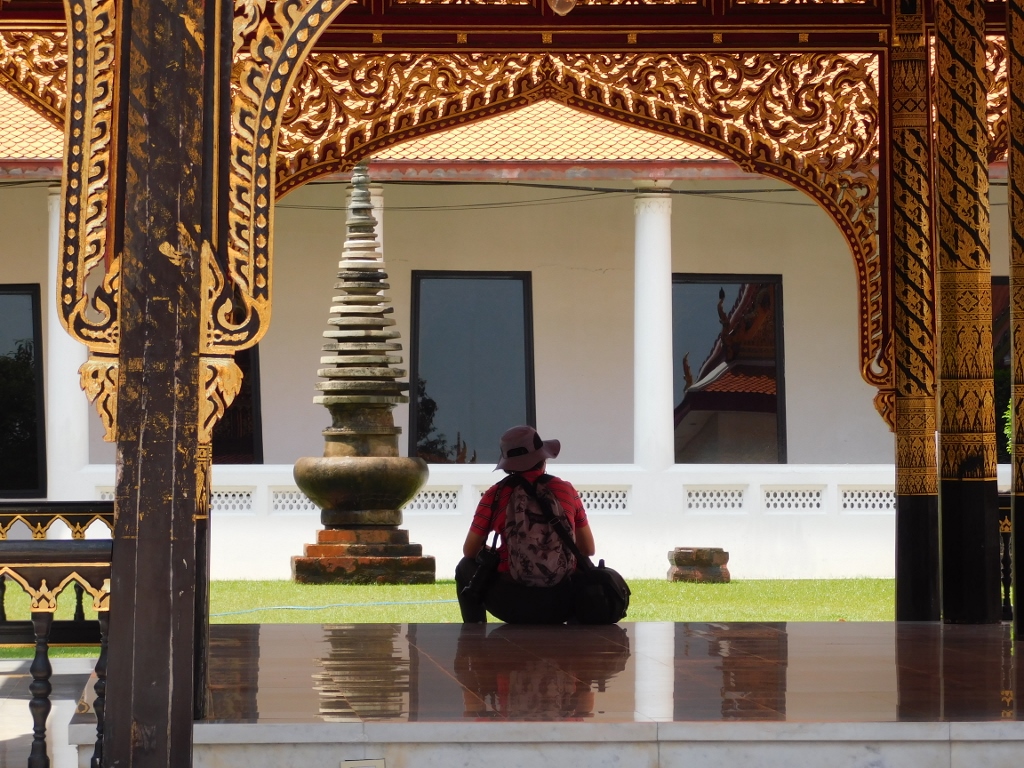 The National Museum Bangkok, a detail
The National Museum Bangkok, a detail
To the side from the central building, which is the largest and houses galleries with traditional Thai crafts and art exhibits, primarily related to their use by the royal family, there are two buildings showcasing archaeological exhibits from both pre-13th century and post-13th century CE periods.
Of course, there are numerous exhibits to explore here and it takes much more time and a deeper understanding of the history, religion and art history, all related to Southeast Asia, for a visitor to fully appreciate this. I only superficially looked around and occasionally paid attention to different exhibits that particularly caught my eye. First, I visited the side wings of the museum.
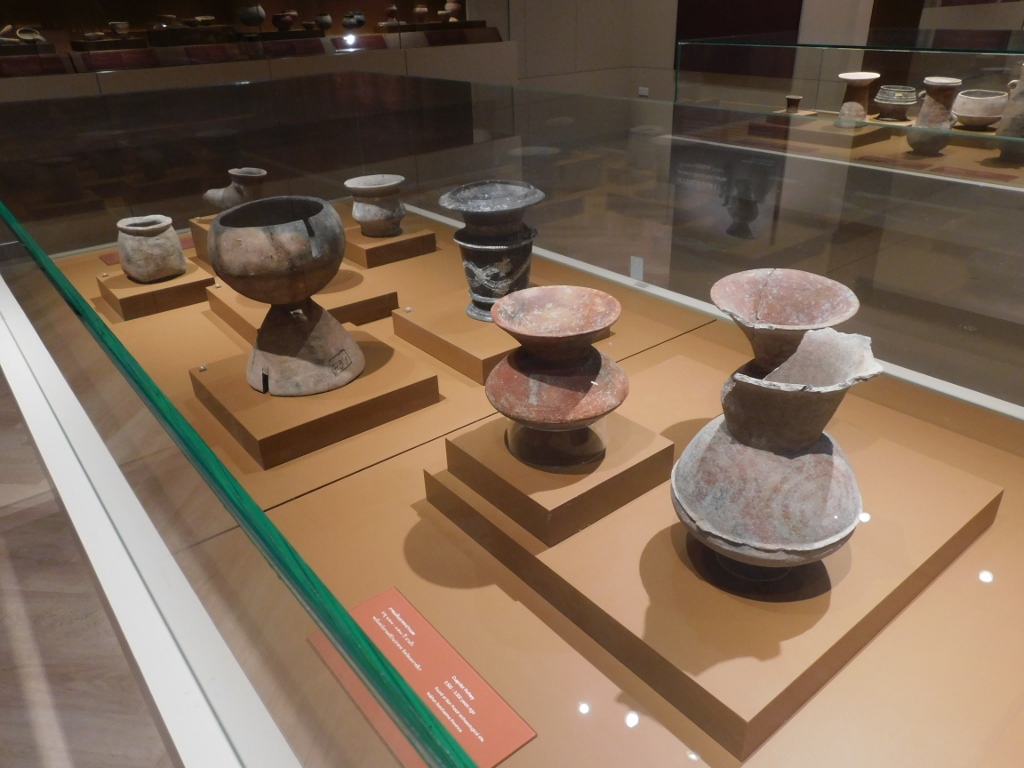 The National Museum Bangkok, a detail
The National Museum Bangkok, a detail
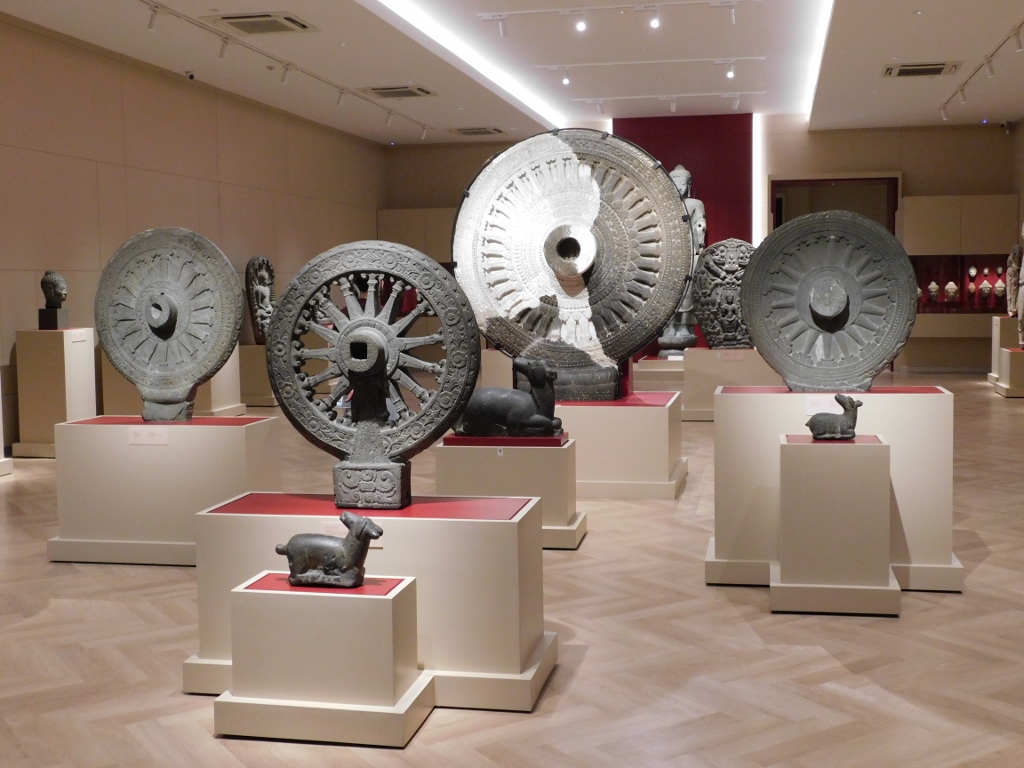 The National Museum Bangkok, a detail
The National Museum Bangkok, a detail
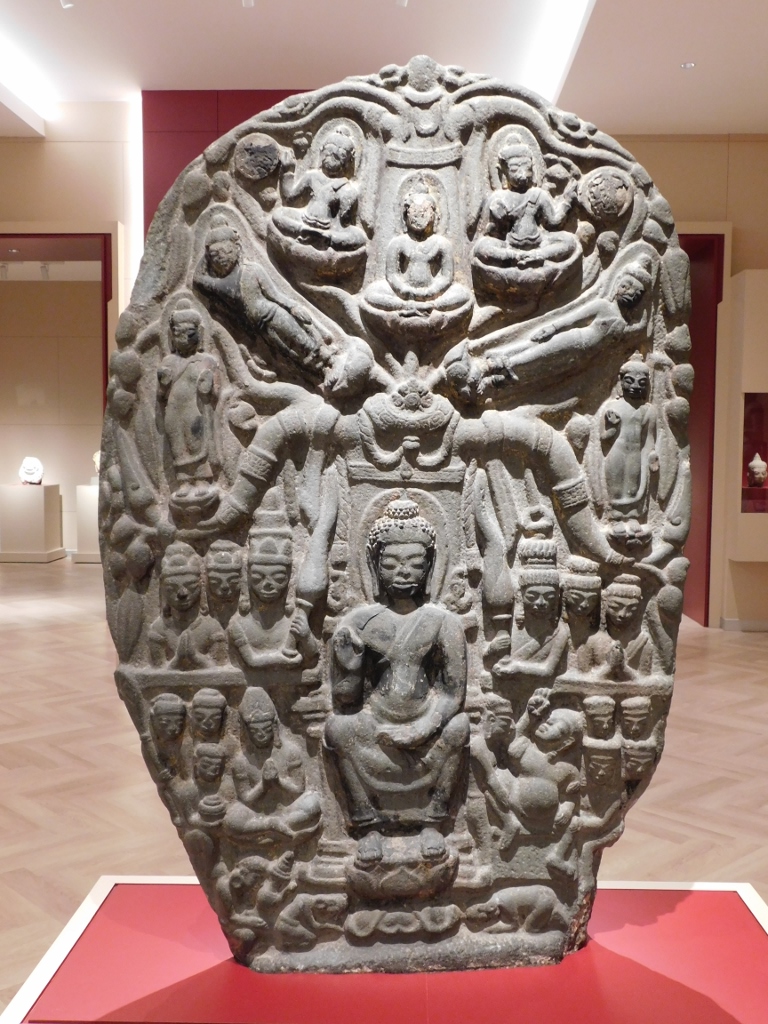 The National Museum Bangkok, a detail
The National Museum Bangkok, a detail
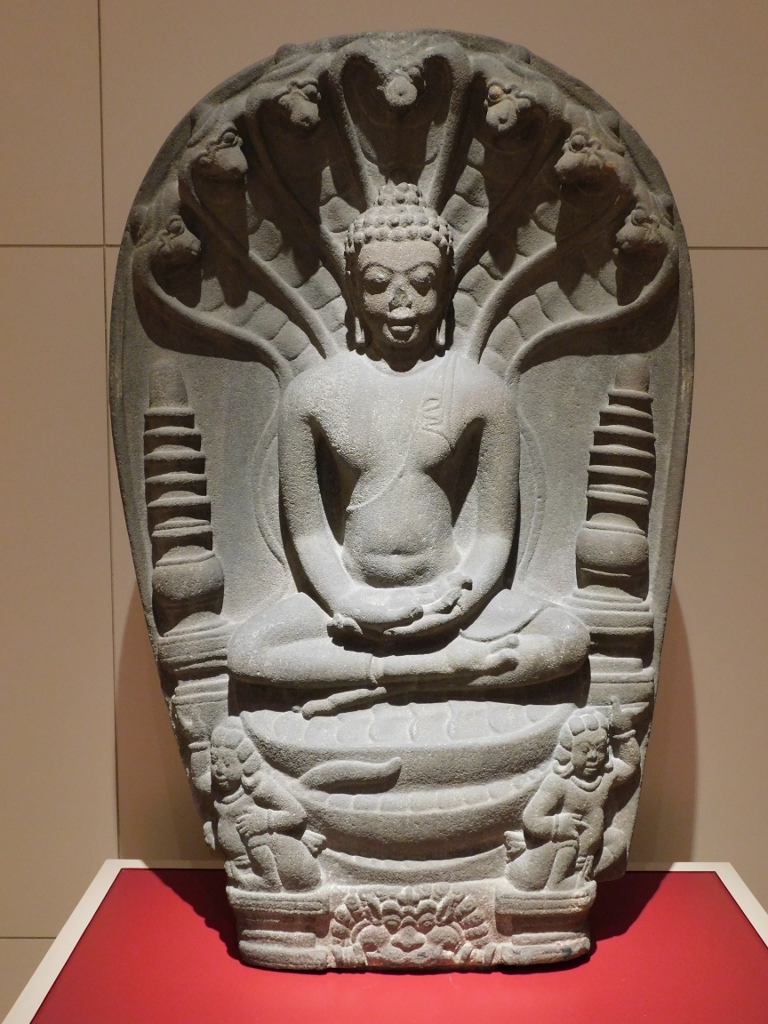 The National Museum Bangkok, a detail
The National Museum Bangkok, a detail
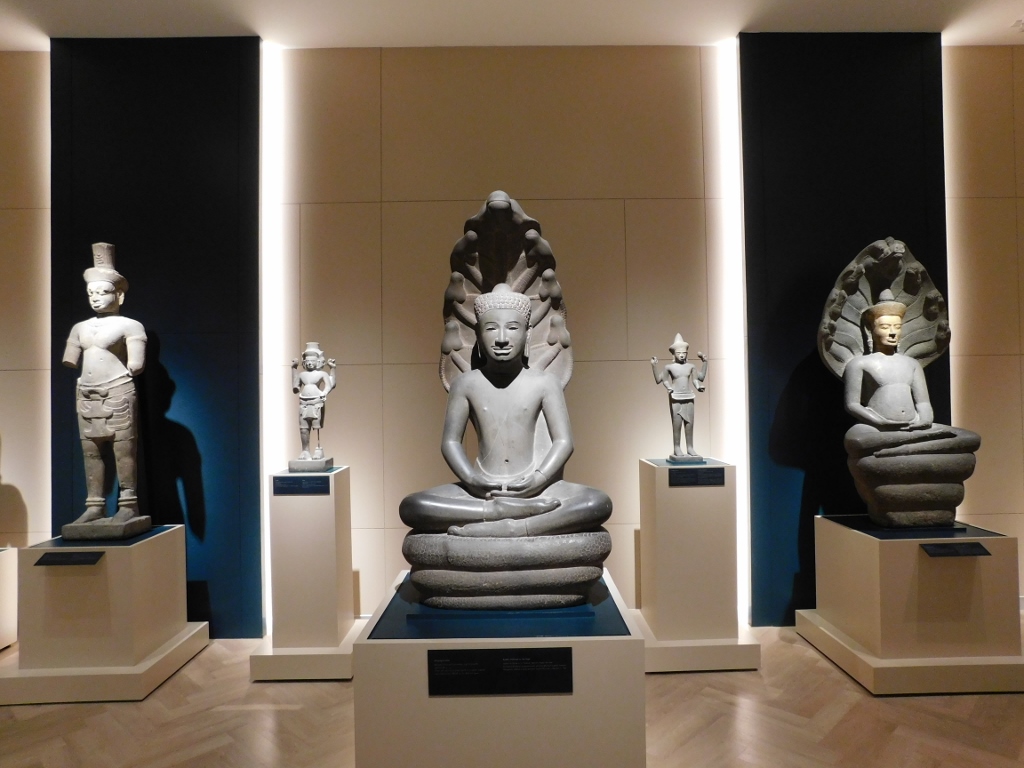 The National Museum Bangkok, a detail
The National Museum Bangkok, a detail
I also came across a statue of the Hindu deity Ganesha with four arms, dating back to the 10th or 11th century CE. This statue was a gift to King Rama V from a representative of the Dutch government on the island of Java in Indonesia. It’s impressive how colonisers, besides taking or, let’s say, stealing everything they could get their hands on, also gave away left and right the things that weren’t theirs to give.
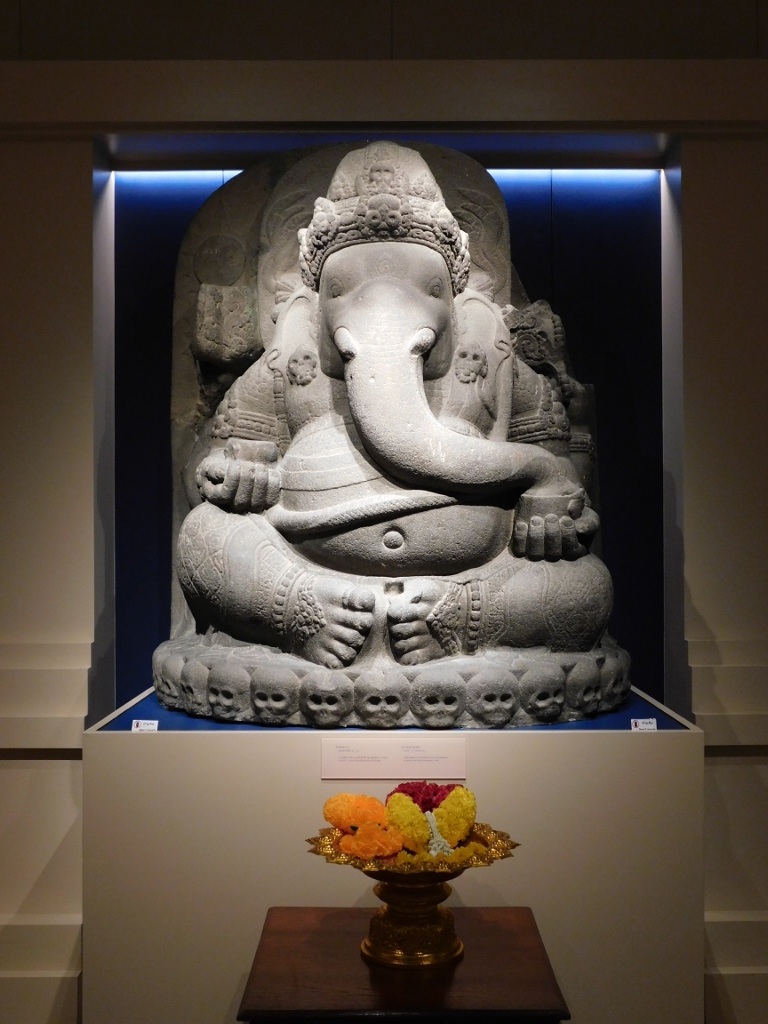 The National Museum Bangkok, a detail
The National Museum Bangkok, a detail
In addition to the objects and statues made of stone, there are also many exhibits made of gold or gilded and there are also ceramic artefacts.
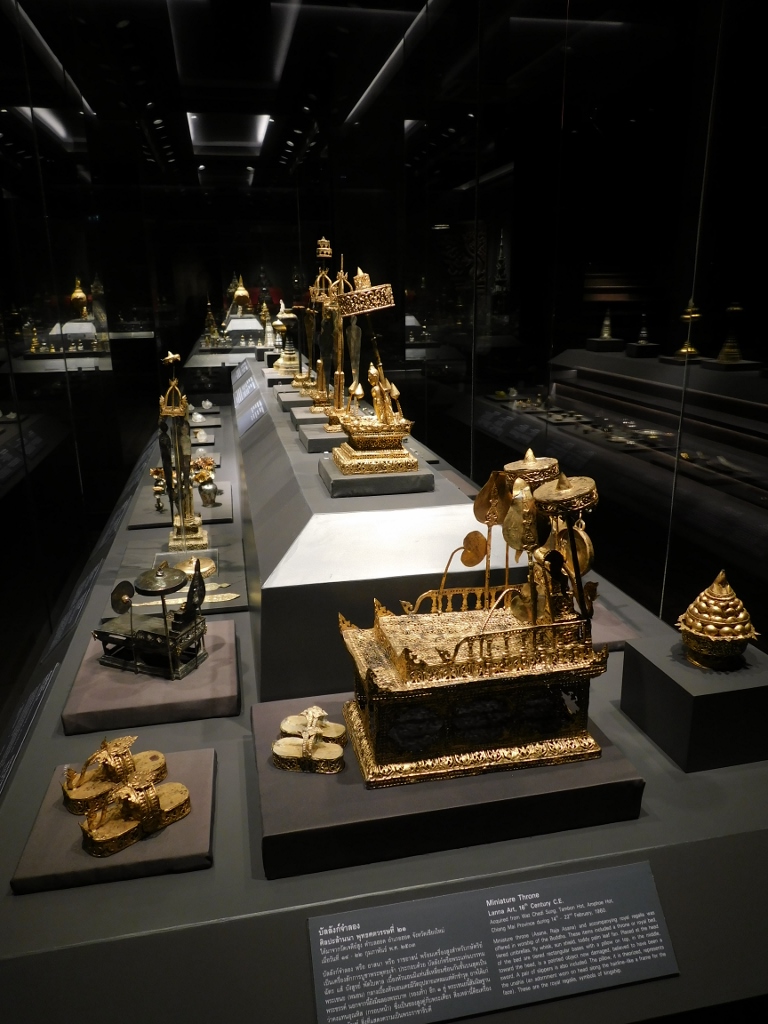 The National Museum Bangkok, a detail
The National Museum Bangkok, a detail
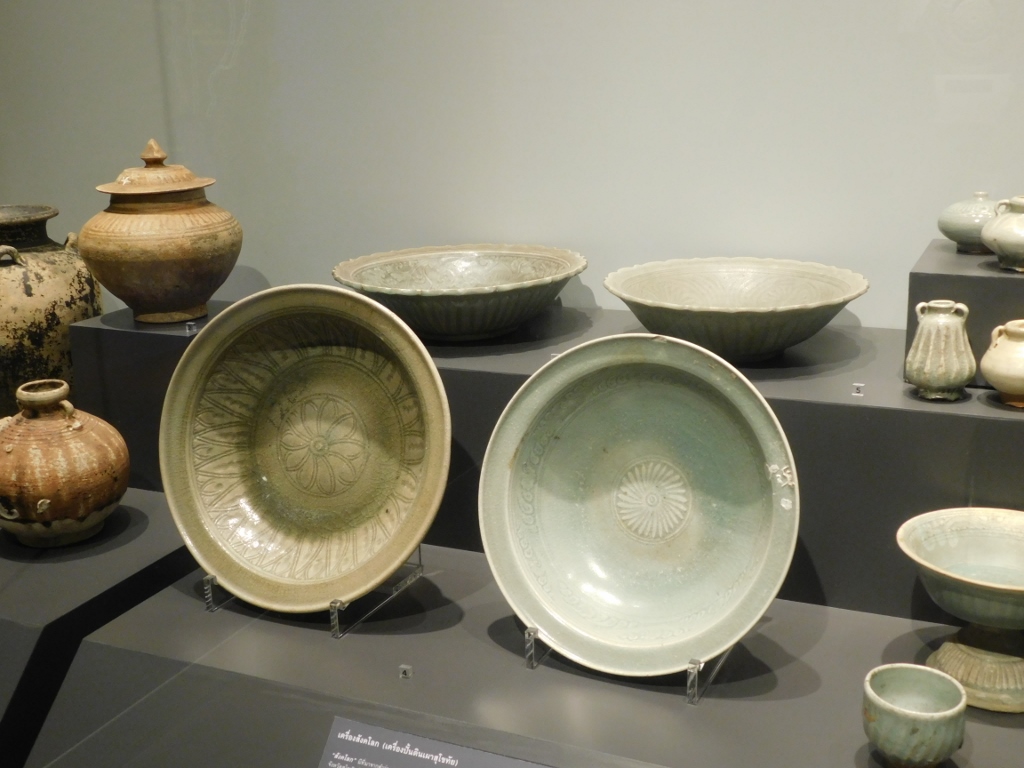 The National Museum Bangkok, a detail
The National Museum Bangkok, a detail
After visiting the side buildings, I went to another building where royal funeral chariots are exhibited.
Namely, the funeral of members of the royal family is a very complex matter in Thailand and, among other things, it includes richly decorated chariots, as well as the coffin and urn placed on the royal pyre, as the deceased are cremated. Around the pyre, figures of various deities are arranged and there are also figures of mythical creatures. All of this and many other details can be seen in this building of the National Museum Bangkok that I now entered.
 The National Museum Bangkok, a detail
The National Museum Bangkok, a detail
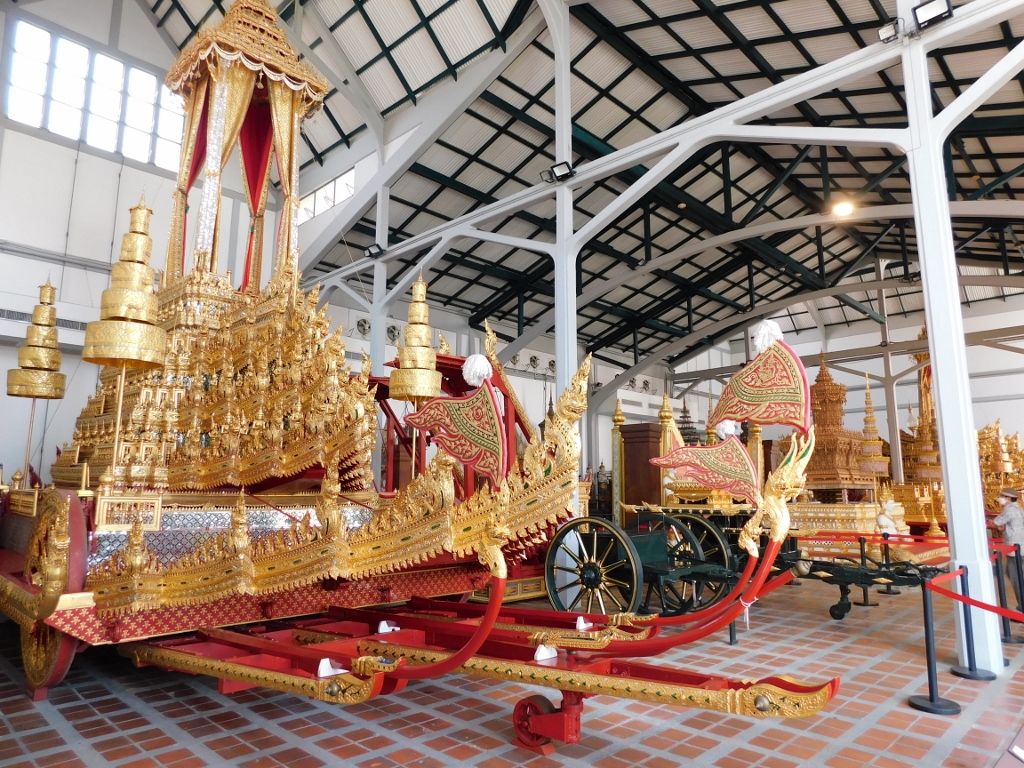 The National Museum Bangkok, a detail
The National Museum Bangkok, a detail
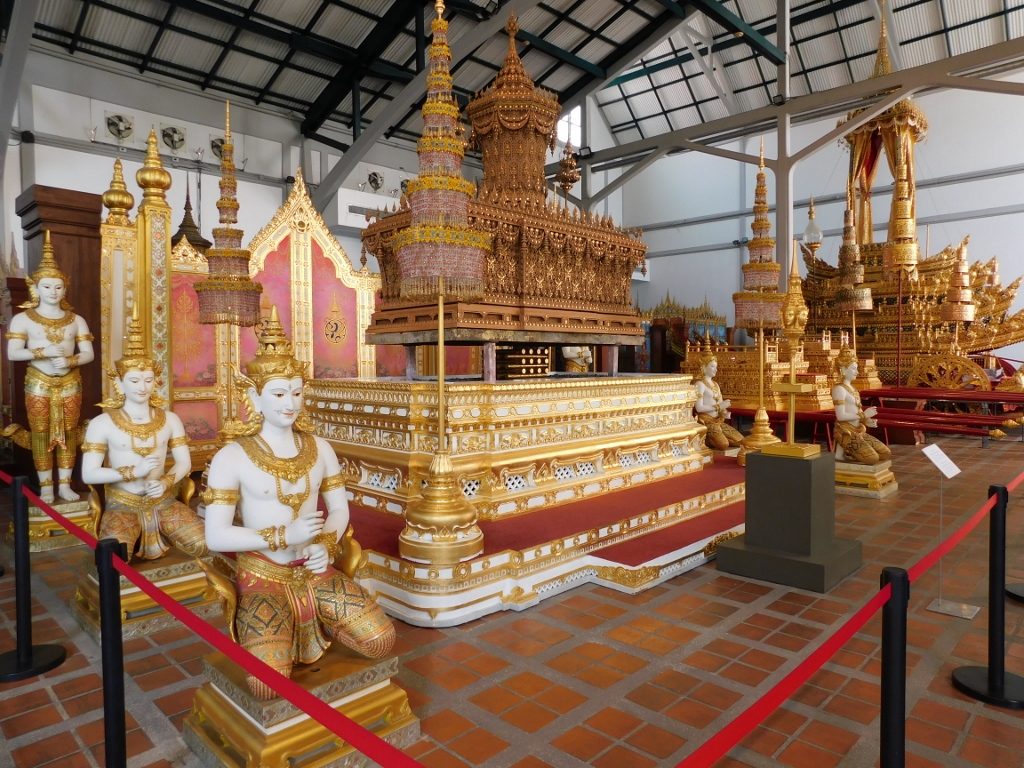 The National Museum Bangkok, a detail
The National Museum Bangkok, a detail
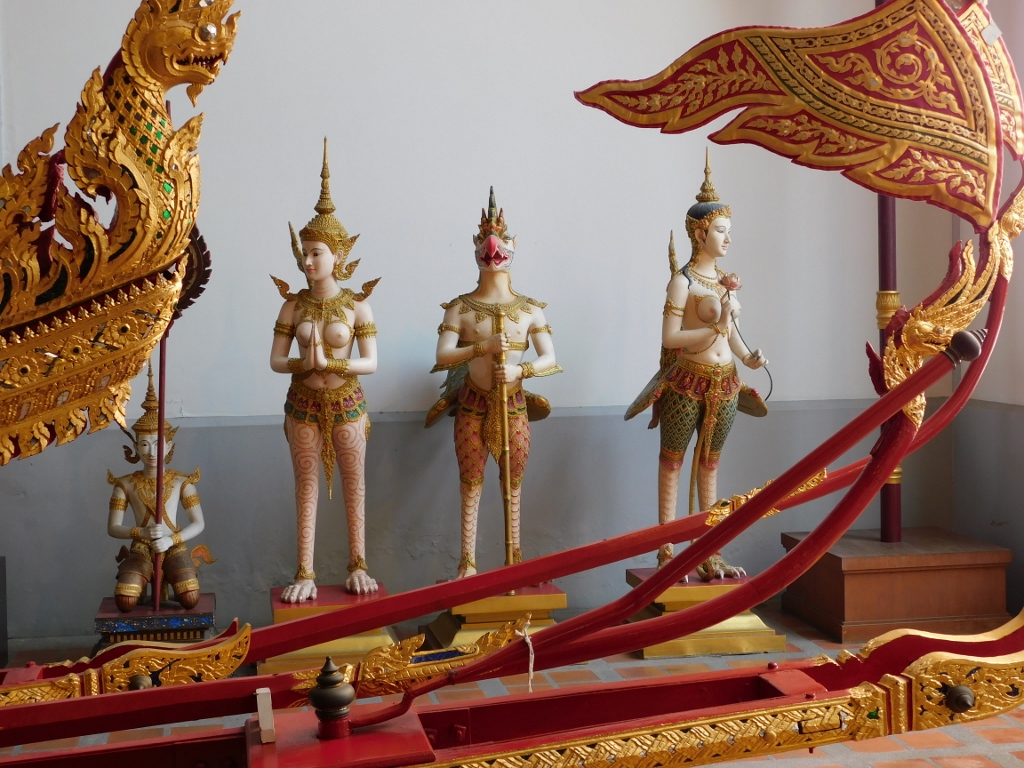 The National Museum Bangkok, a detail
The National Museum Bangkok, a detail
I found it interesting to read that mythical creatures (three types can be seen in the previous photo) decorating the royal pyre actually symbolise Mount Meru or Sumeru, which according to the Hindu and Buddhist traditions represents the centre of the universe. The first one from the left is Apsara Siha, half woman, half bird. In the middle is Dandima, holding a stick, and on the right is Kinnaree, again half woman, half bird. This is probably an unnecessary level of detail for my travelogue, but these figures fascinated me, so I paid attention to them and their names.
Now I went to visit the largest building within the National Museum Bangkok. There, one can see the thrones of the Thai monarchs, but throughout the rooms in this central museum building, once a palace, various other exhibits related to life at the Thai court can also be seen.
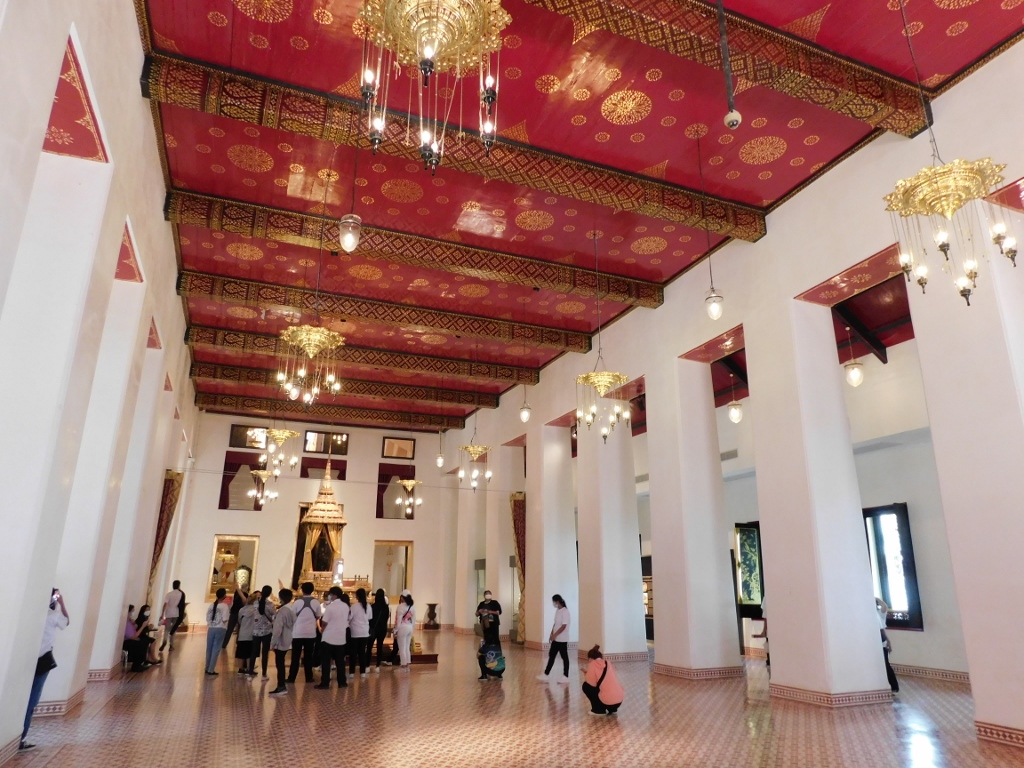 The National Museum Bangkok, a detail
The National Museum Bangkok, a detail
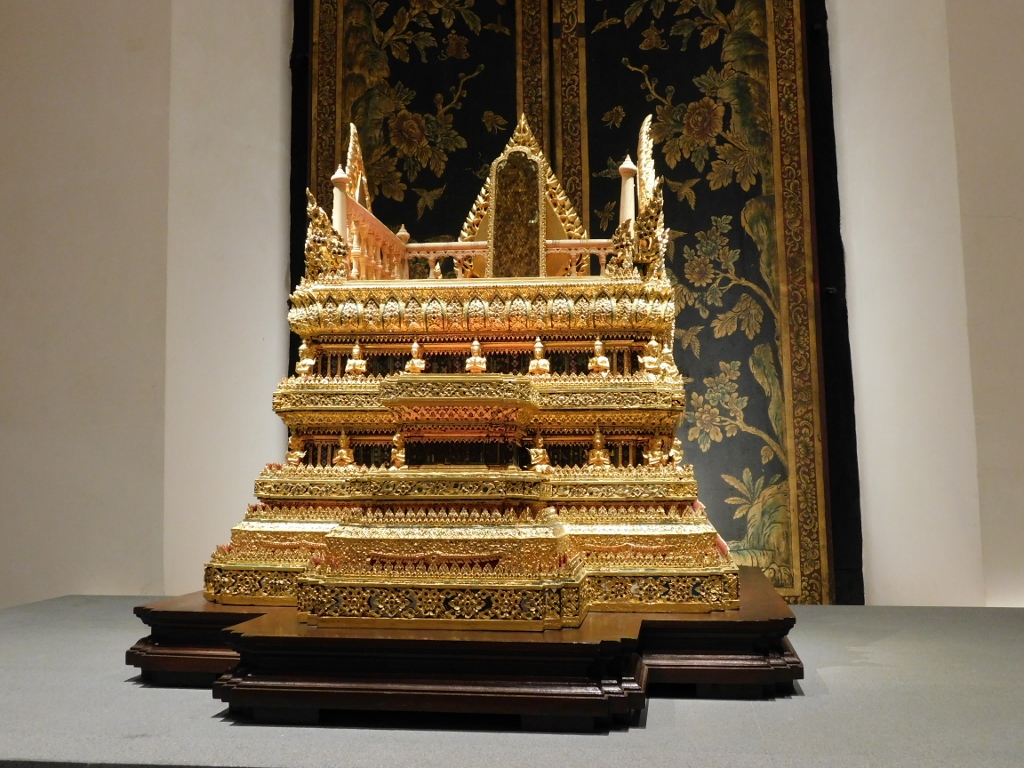 The National Museum Bangkok, a detail
The National Museum Bangkok, a detail
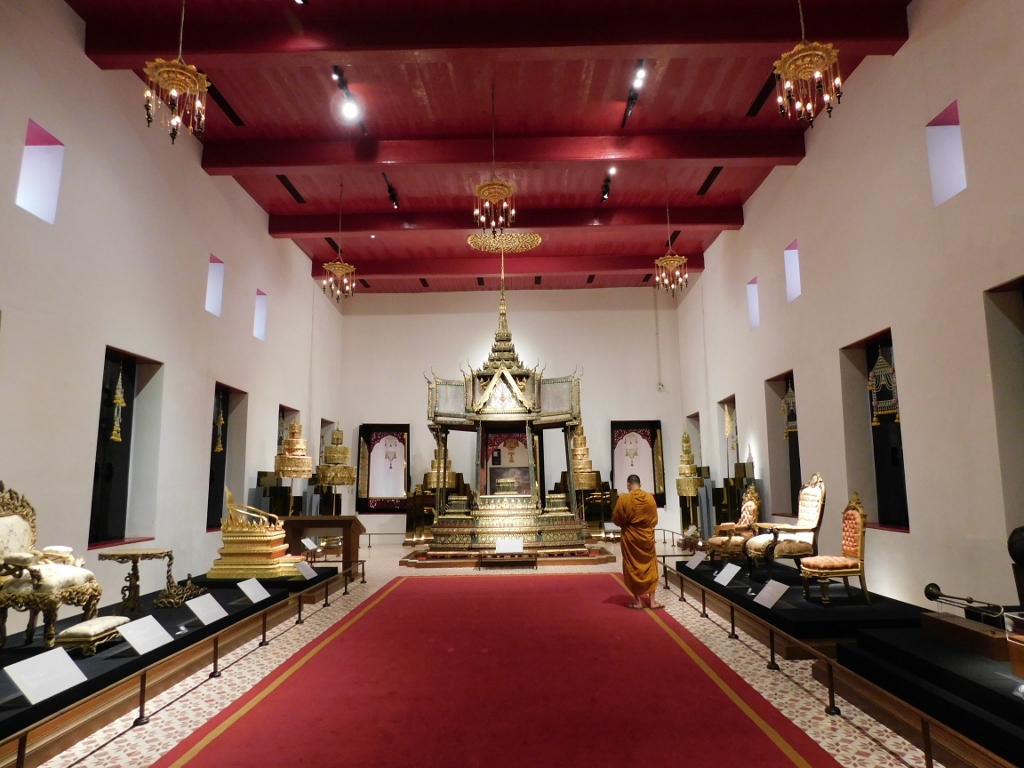 The National Museum Bangkok, a detail
The National Museum Bangkok, a detail
Among other things, I found the masks called the khon masks interesting. They have been used since the Ayutthaya Kingdom era in plays that entertain the royal family and the themes are usually traditional.
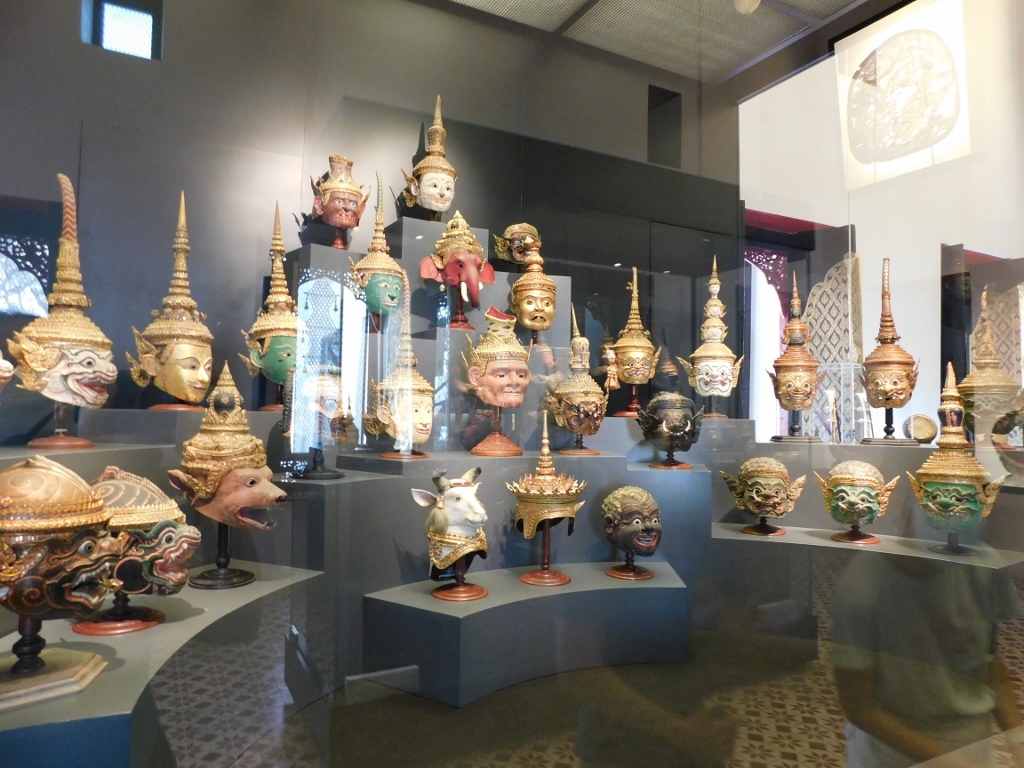 The National Museum Bangkok, a detail
The National Museum Bangkok, a detail
There is also a room where various instruments used in the Thai classical music are displayed.
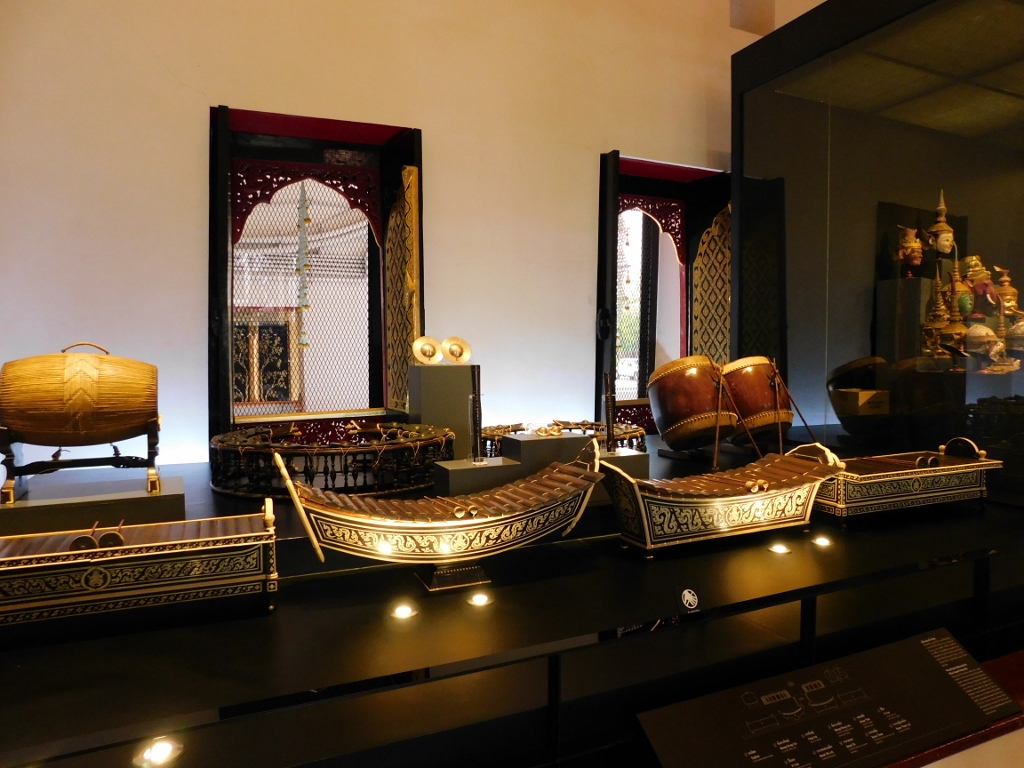 The National Museum Bangkok, a detail
The National Museum Bangkok, a detail
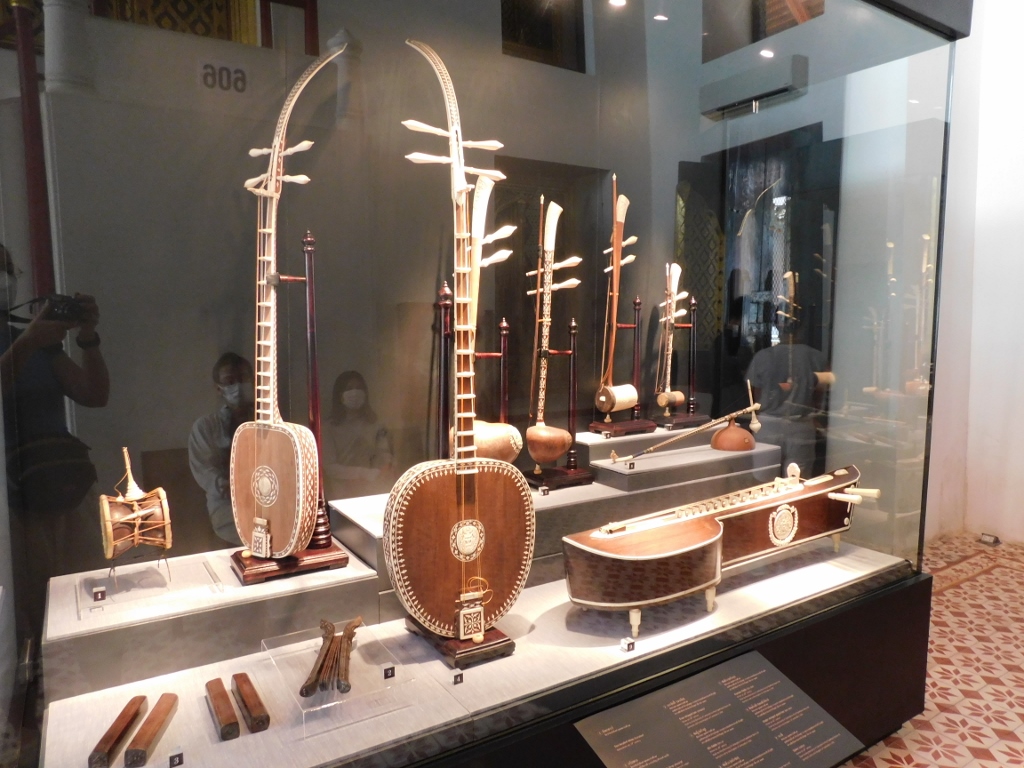 The National Museum Bangkok, a detail
The National Museum Bangkok, a detail
Of course, as someone who engages in ceramics as a hobby, I was fascinated when I reached the royal porcelain section. Although the exhibited items were used for the needs of the Thai royal family and nobility, the porcelain was made in China based on special designs.
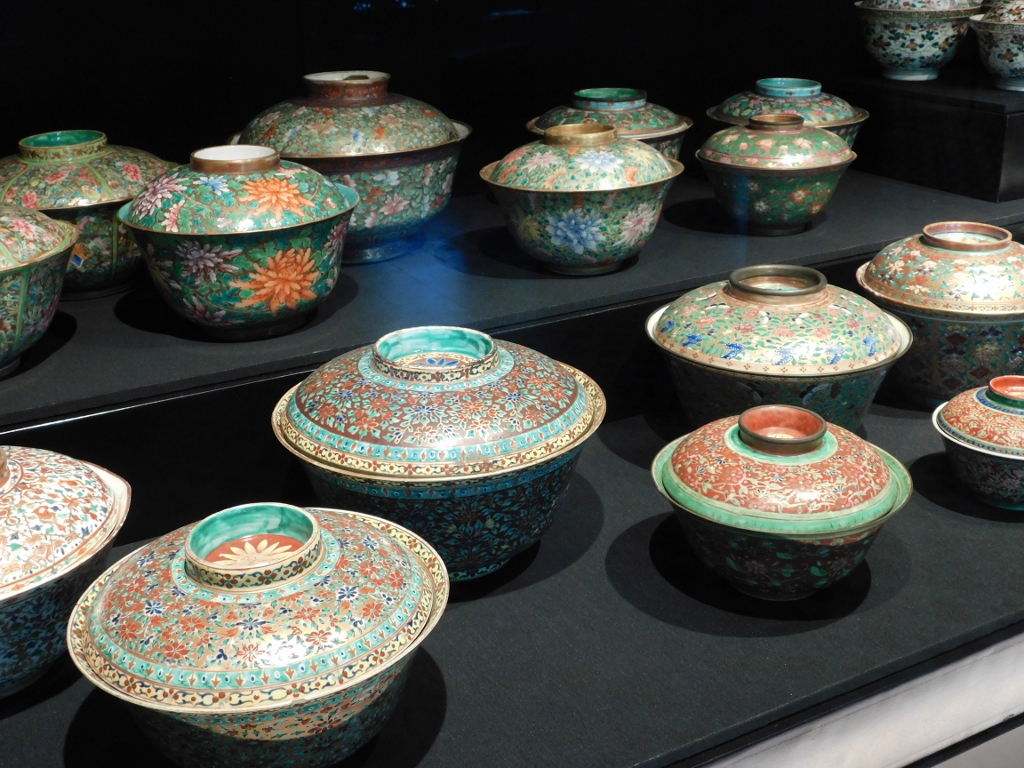 The National Museum Bangkok, a detail
The National Museum Bangkok, a detail
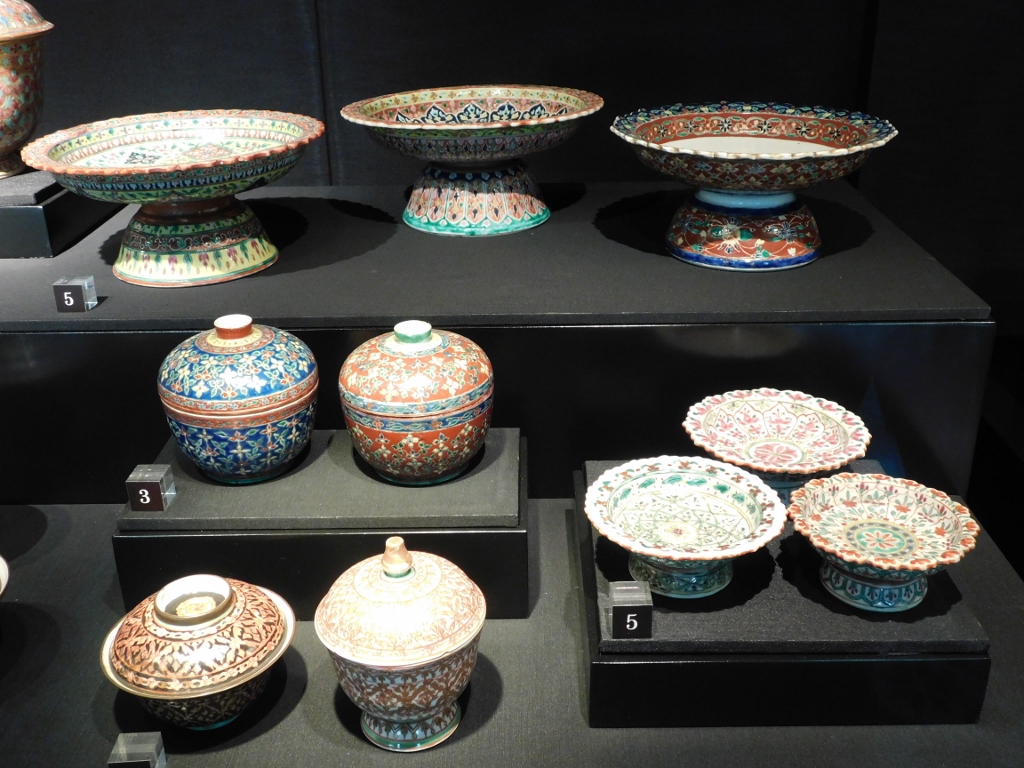 The National Museum Bangkok, a detail
The National Museum Bangkok, a detail
I was particularly intrigued by the seats that were specially made to be used on the backs of elephants. This type of seat is called a ‘hauda.’ In the museum, you can see several different haudas that were made specifically for individual elephants and intended users. Haudas were used either for travel during military campaigns or during royal ceremonies.
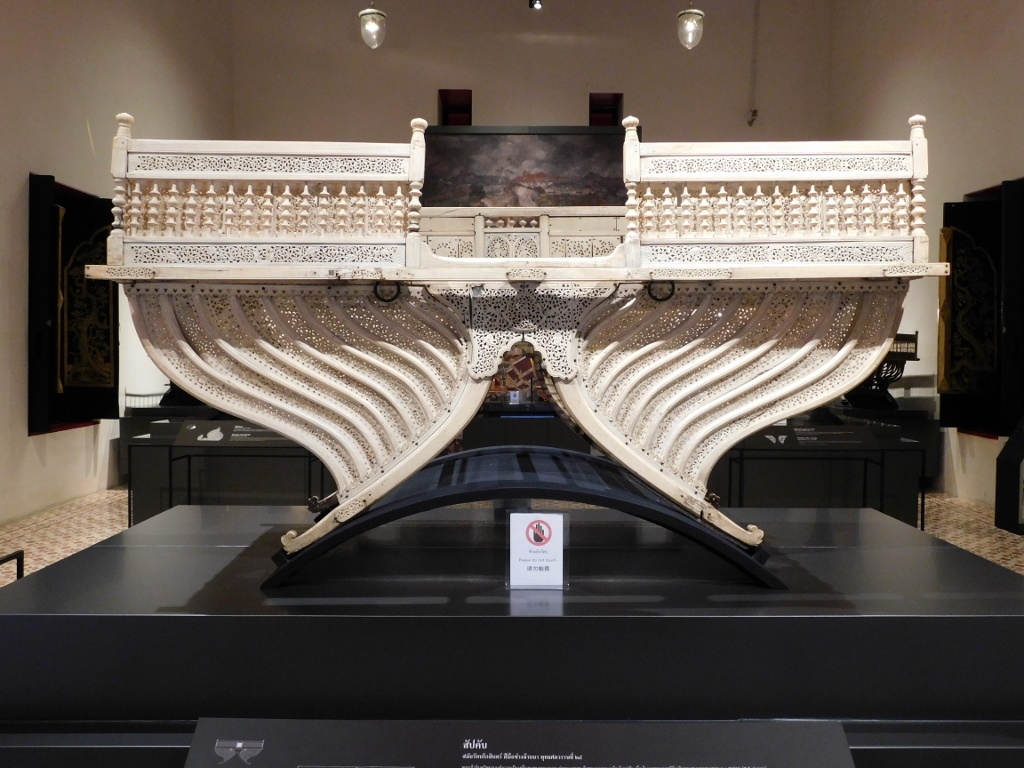 The National Museum Bangkok, a detail
The National Museum Bangkok, a detail
There is a whole myriad of diverse exhibits to see, but I would like to highlight the fans I saw in glass cases in one of the rooms.
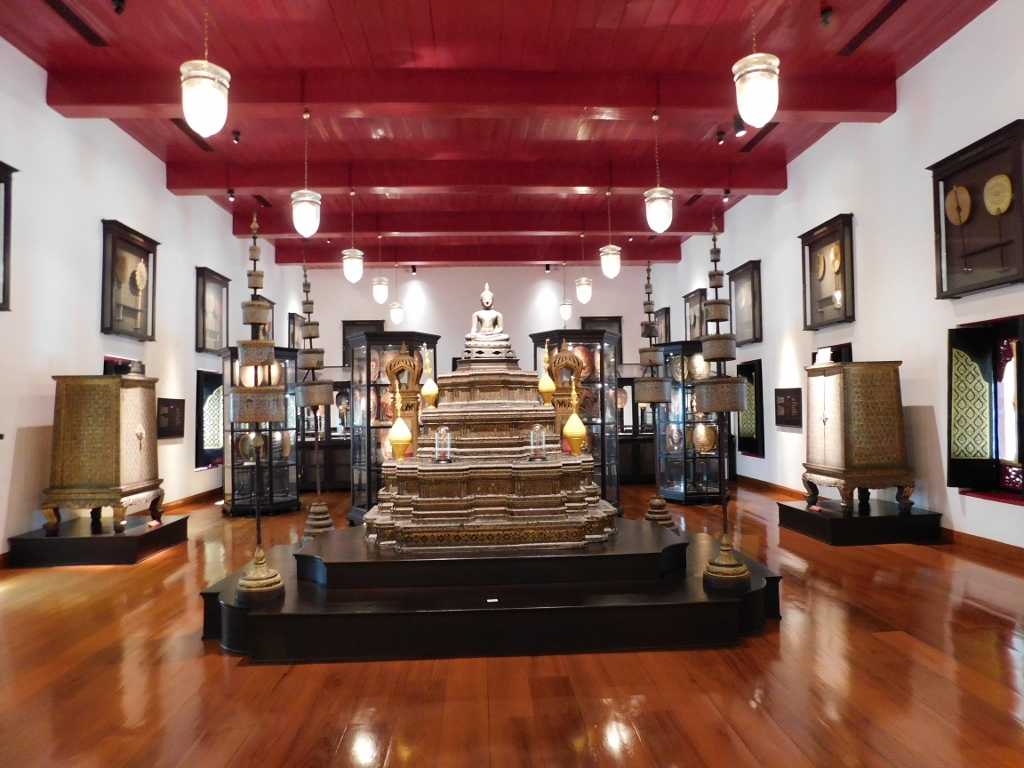 The National Museum Bangkok, a detail
The National Museum Bangkok, a detail
Many of these fans are commemorative fans made, for instance, on the occasion of royal birthdays, but the fans were also made to reflect the rank of the person for whom they were intended. I read somewhere that specially crafted fans were awarded to monks as a form of honour for their good conduct.
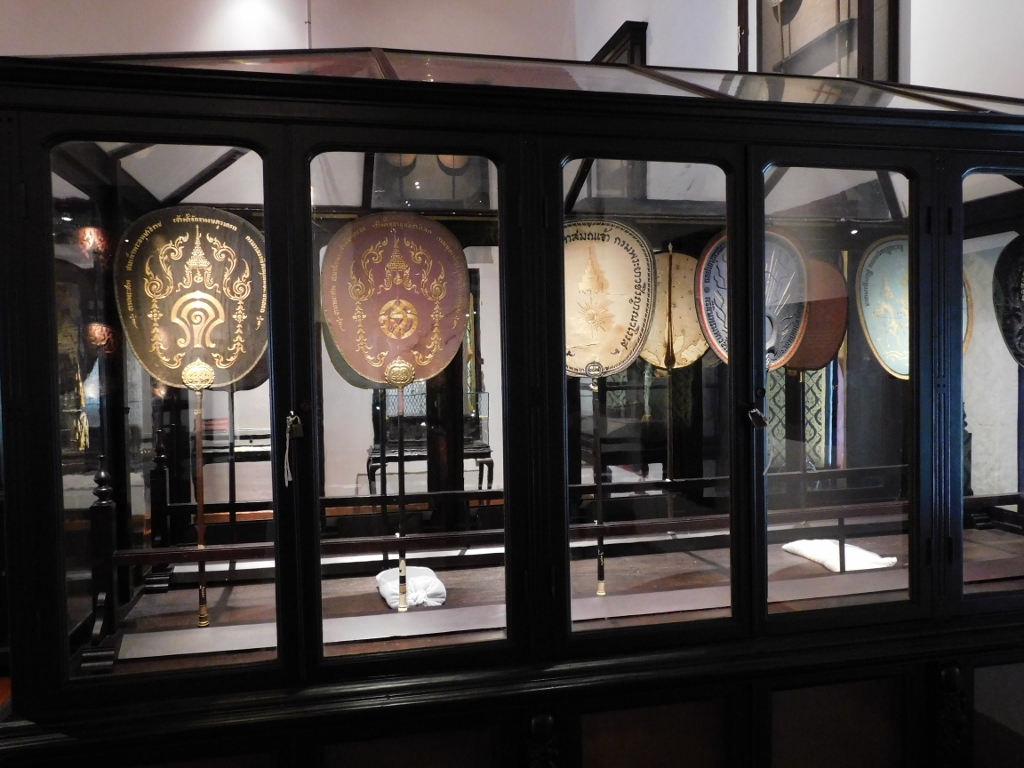 The National Museum Bangkok, a detail
The National Museum Bangkok, a detail
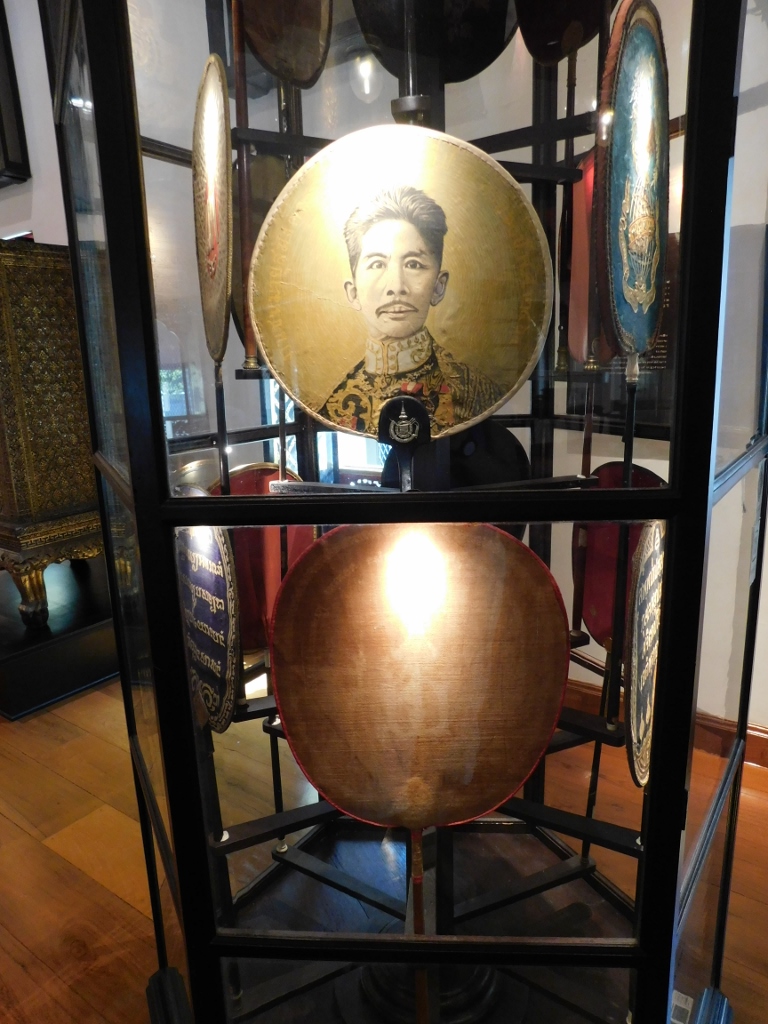 The National Museum Bangkok, a detail
The National Museum Bangkok, a detail
The National Museum Bangkok was fantastic and I certainly enjoyed it. It was important for me to visit it “as soon as possible” because the museum is closed on Mondays and Tuesdays, and I easily could have run out of time to explore it before continuing my journey. On the other hand, with so many different exhibits, I wondered if it was a good idea to come here before touring Thailand and before getting acquainted with the various parts of the history of this beautiful and exotic country. Ideally, I probably should have visited the museum both at the beginning and the end of my trip. However, that wasn’t realistic.
Having finished my tour of the National Museum Bangkok, I started heading back to my hotel. Along the way, I passed through a part of the city that is extremely popular among (younger) tourists, especially those travelling with backpacks. Although, it should be noted that I was also travelling with a backpack (or more precisely, backpackS – one large and one small), but I preferred a quieter area compared to the one I was walking through. I passed through some backstreet alleys again, but I wasn’t worried at all.
Bangkok is a fairly safe city, but regardless of the overall safety of visitors and the predominant adherence to a “peaceful” religion like Buddhism, one should not have illusions. People are people, so I’m sure there are quite a few thefts in homes. How else to explain the large number of bars on the balconies?
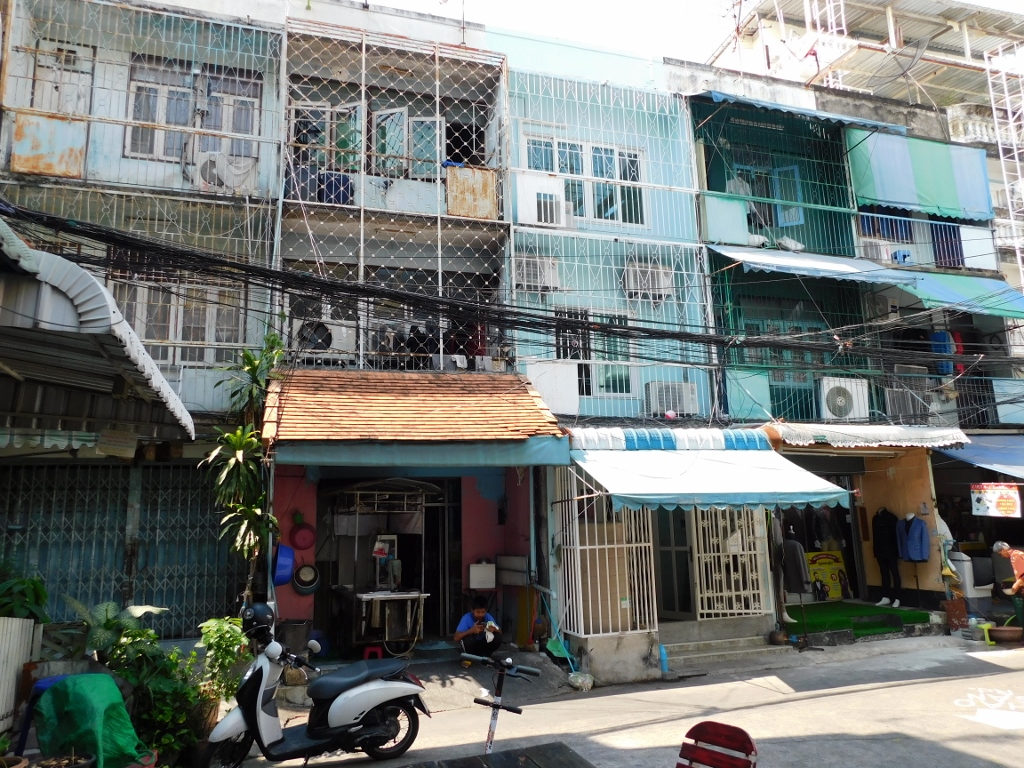 Bangkok, a detail
Bangkok, a detail
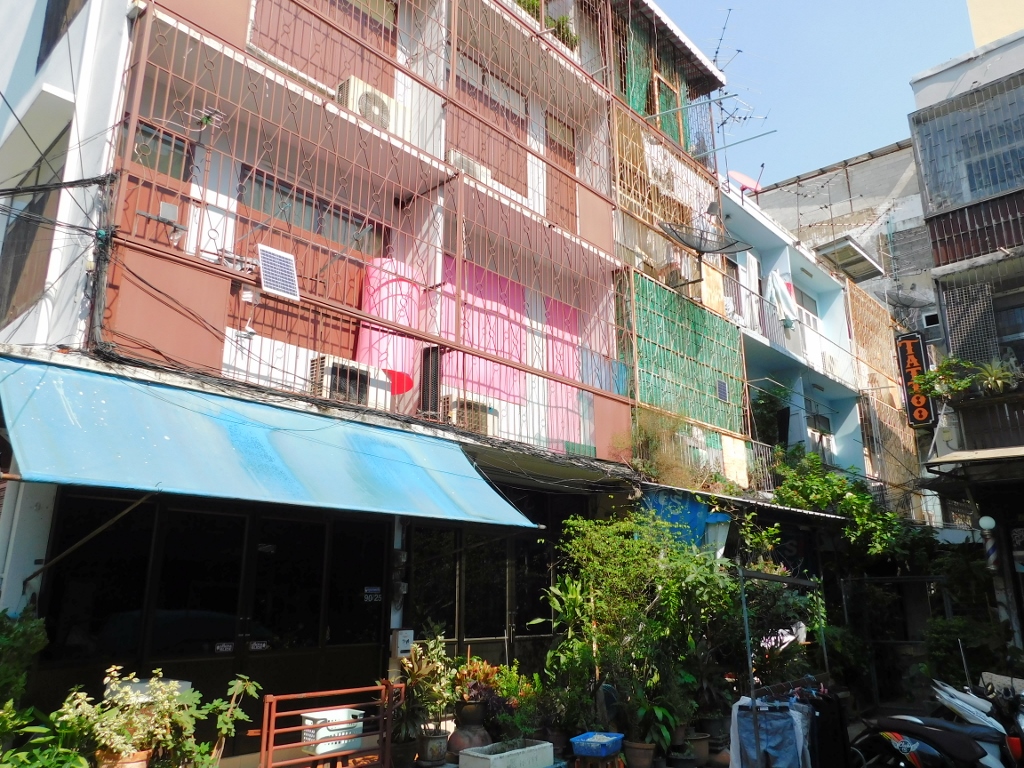 Bangkok, a detail
Bangkok, a detail
Here I sat down in a restaurant in order to get a refreshing drink. In the meantime, I also bought more water, but it was important for me to consume another type of liquid. That break was enjoyable, but then I continued towards the hotel to rest some more. Along the way, I passed by Wat Bowonniwet Temple with its golden chedi, about 50 meters high.
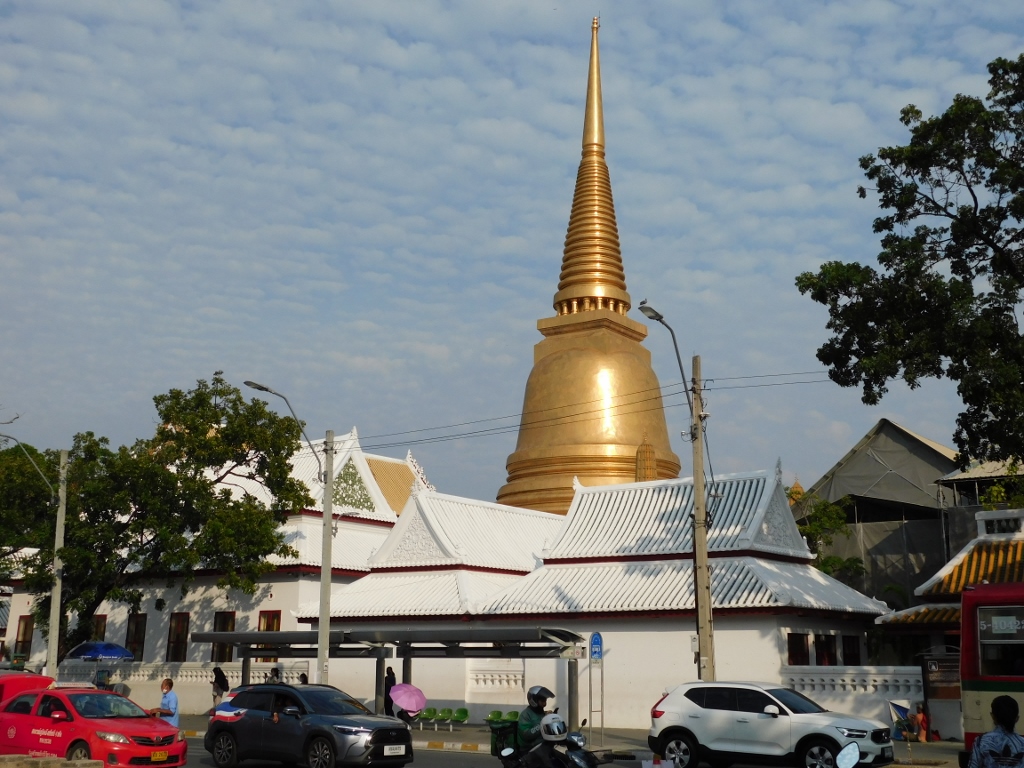 Wat Bowonniwet
Wat Bowonniwet
After a couple of hours, I was ready to take another stroll, but this time I combined a visit to another temple with going out for dinner.
The temple is called Wat Suthat. Before the visit, I read my guidebooks, but nothing could prepare me for it. I think until this point in time I liked this one best. It was exceptionally impressive.
But before reaching the temple, I wandered through the streets and alleys of the old centre of Bangkok. It was a bit late in the afternoon and it wasn’t as hot as earlier in the day, making this walk more enjoyable. I think I could appreciate the picturesque scenes I encountered even more.
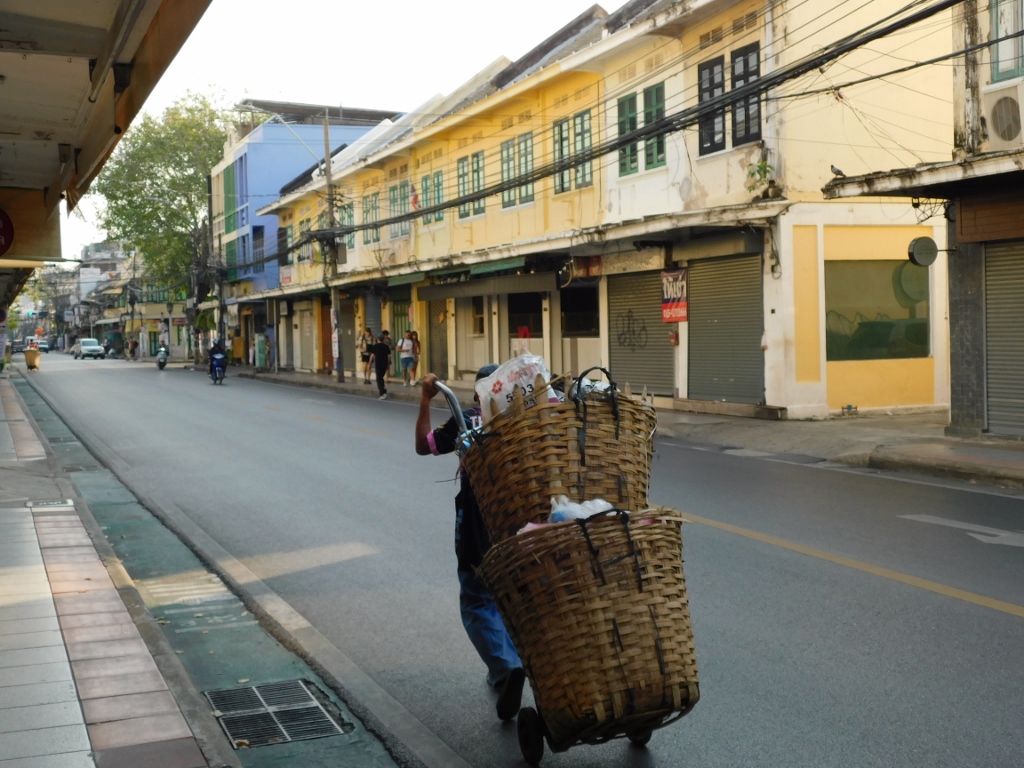 Bangkok, a detail
Bangkok, a detail
At some point, I left the main streets and wandered through alleys, one of which led to a small canal, resembling a shady promenade.
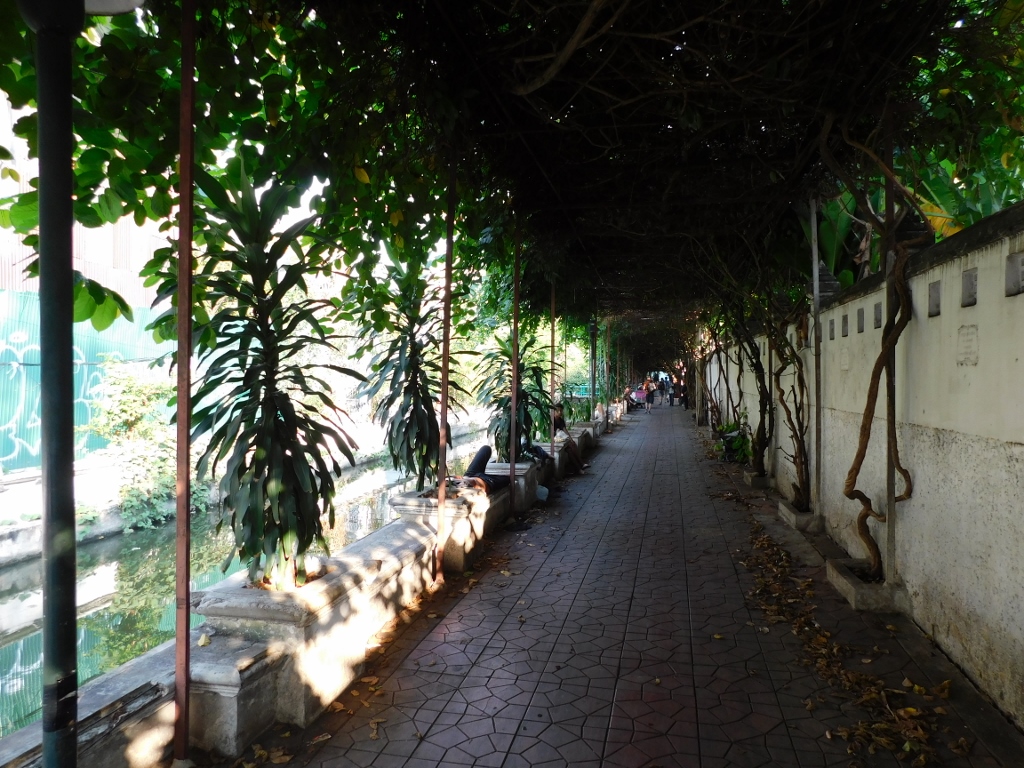 Bangkok, a detail
Bangkok, a detail
Soon, the greenery providing shade disappeared, but with the sun no longer high in the sky, it wasn’t an issue.
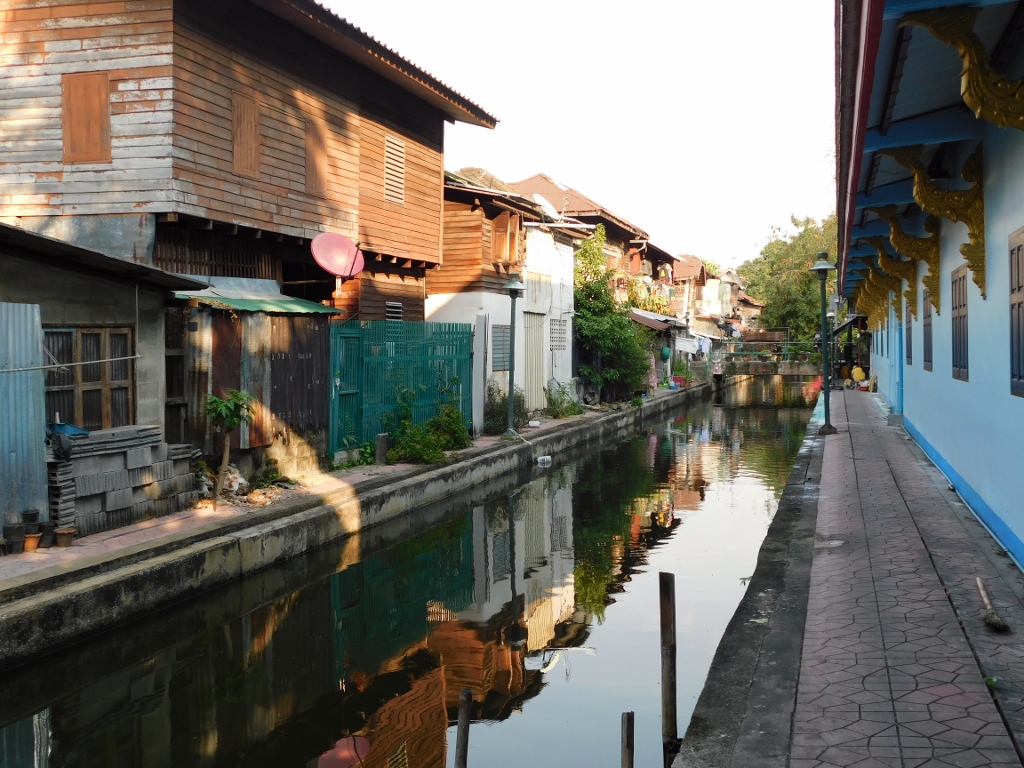 Bangkok, a detail
Bangkok, a detail
Then I left the path along the canal and started winding through the real alleyways between the homes of ordinary Bangkok residents, but at no point did I feel like I might get lost. It was also interesting when I began to realise that in Bangkok, and indeed throughout Thailand, one is never far from a shrine, even if it’s improvised.
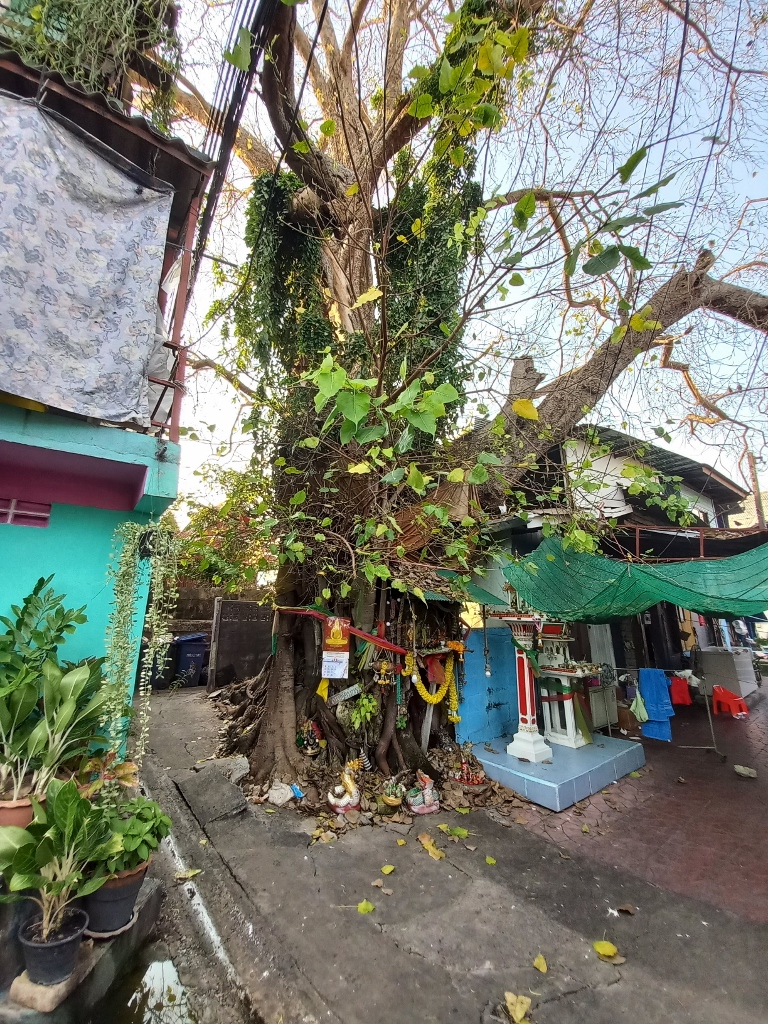 Bangkok, a detail
Bangkok, a detail
For orientation, I used the map I had on my mobile phone, but I also improvised on the spot, always keeping a general direction because I knew exactly where I wanted to go. However, when I noticed a fruit cart in a side street, it was clear to me that I would stop here. The woman who was probably just getting ready to push the cart onto one of the main streets was very happy to sell me some pineapple. She cut it up and put it in a plastic bag for me. It was fantastic!
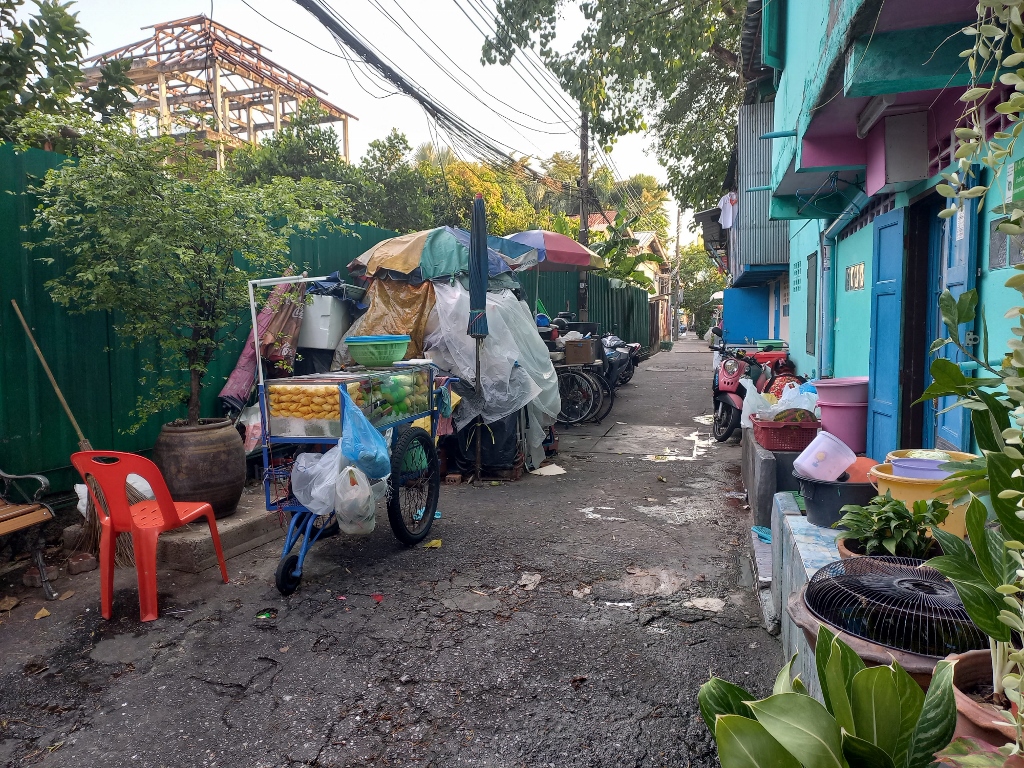 Bangkok, a detail
Bangkok, a detail
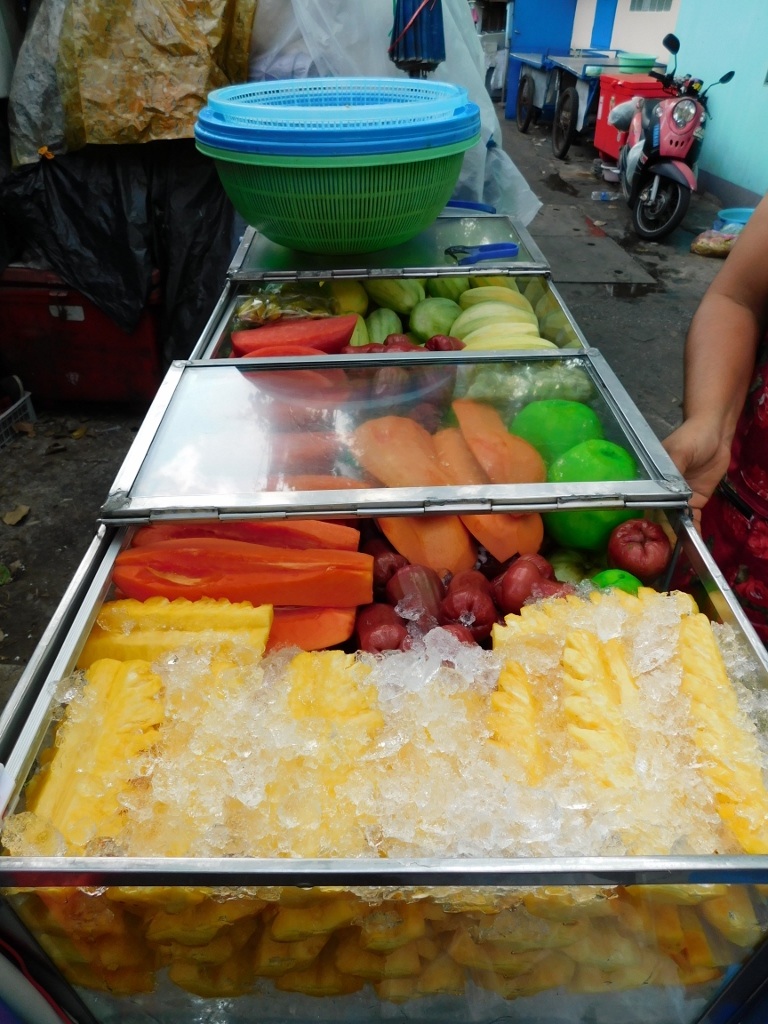 Bangkok, a detail
Bangkok, a detail
Not all alleys were interesting. On the other hand, some were too narrow for anything creative, but in many places, you could see greenery growing in pots, indicating that someone had placed it there.
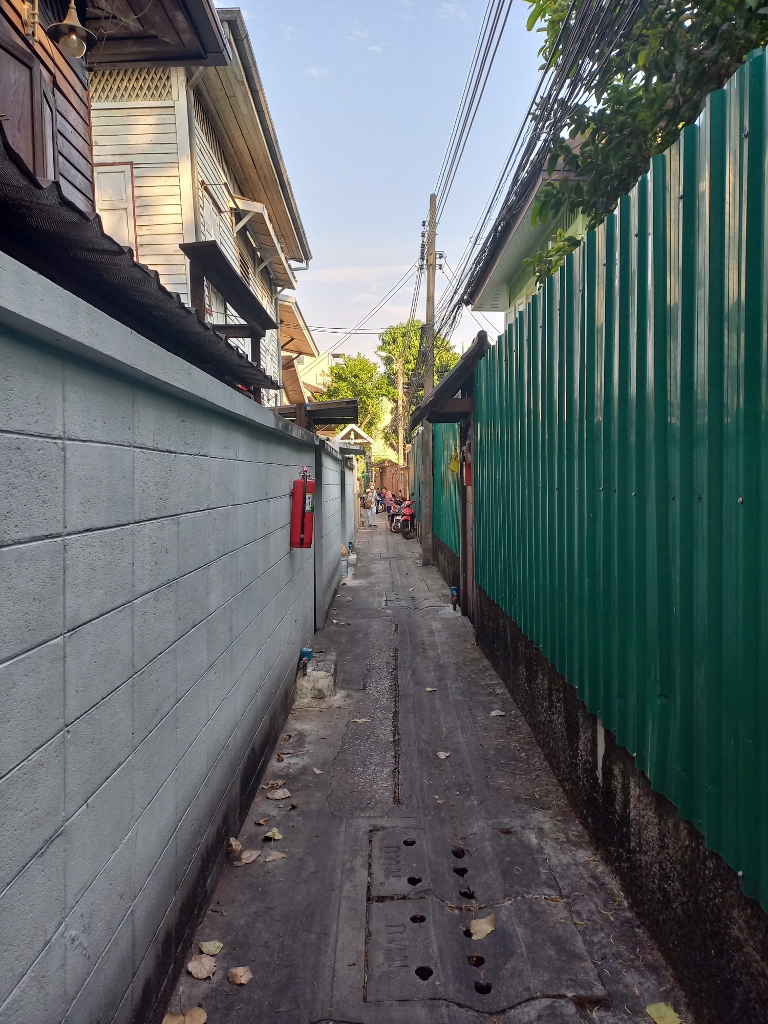 Bangkok, a detail
Bangkok, a detail
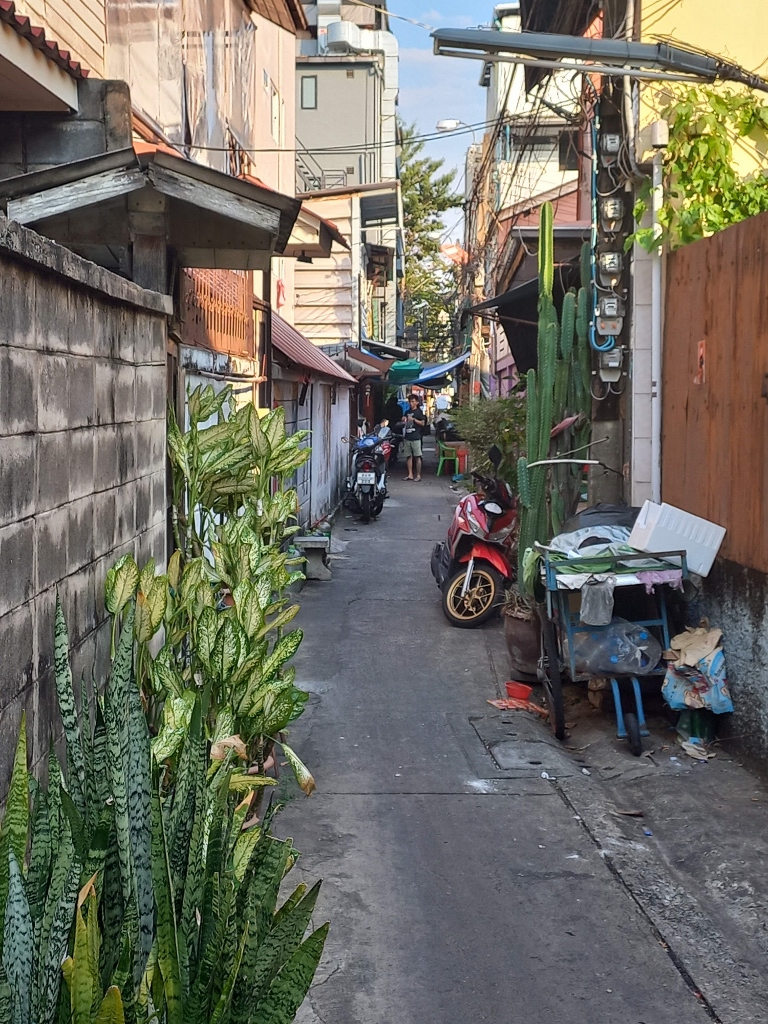 Bangkok, a detail
Bangkok, a detail
As I walked through here, I couldn’t resist and often peeked into the homes and yards of people living in this part of the city. What can I say, everything was quite open and visually absolutely accessible, so I took some photos. This now provides a small and very superficial insight into the daily life of ordinary Bangkok residents.
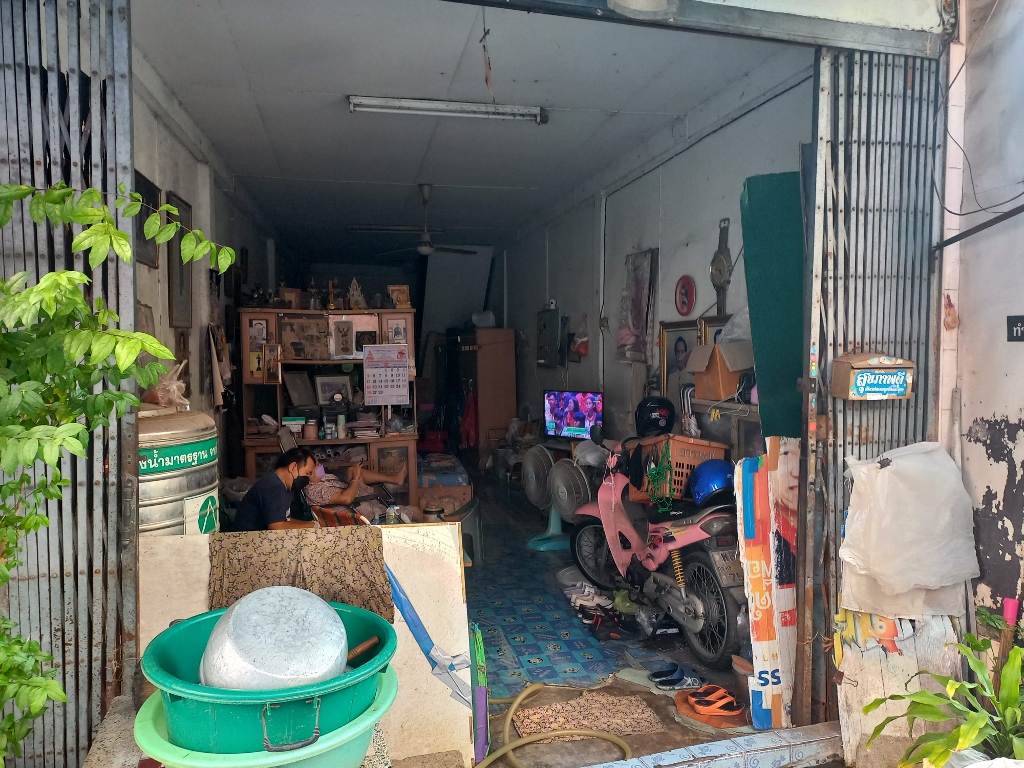 Bangkok, a detail
Bangkok, a detail
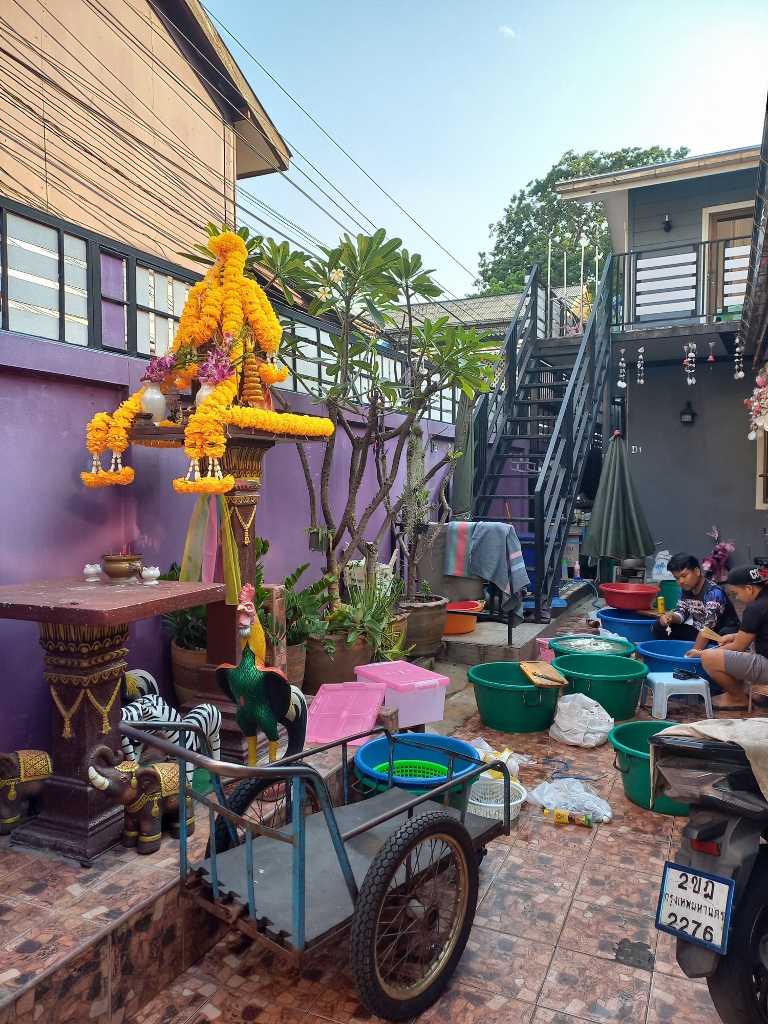 Bangkok, a detail
Bangkok, a detail
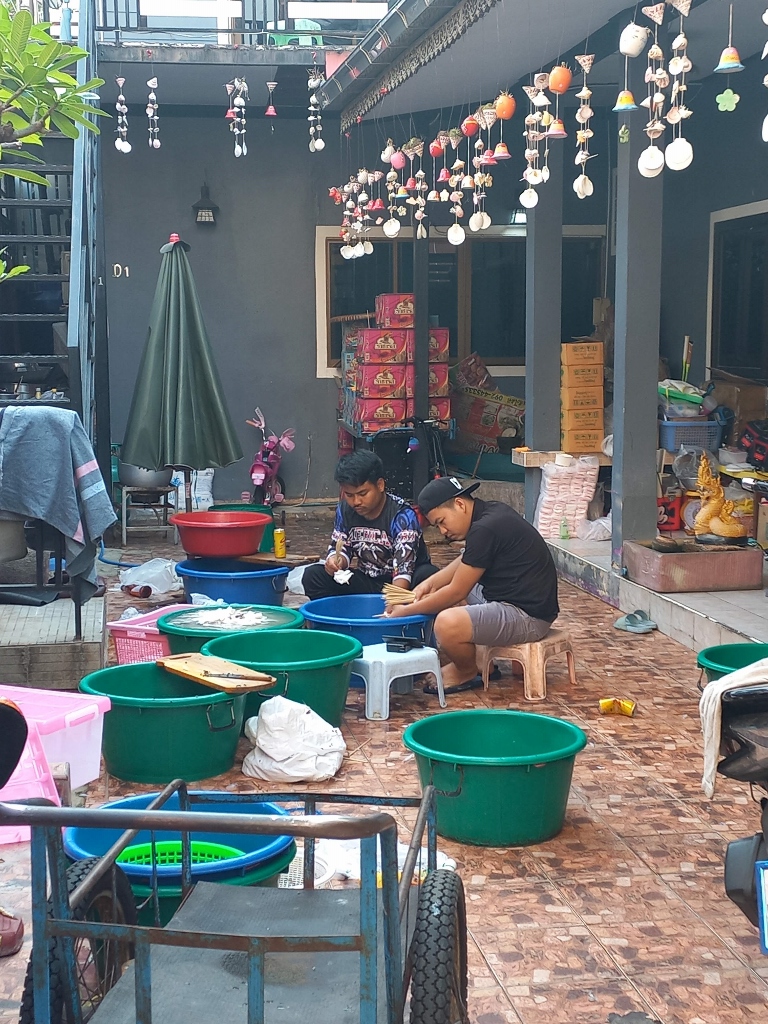 Bangkok, a detail
Bangkok, a detail
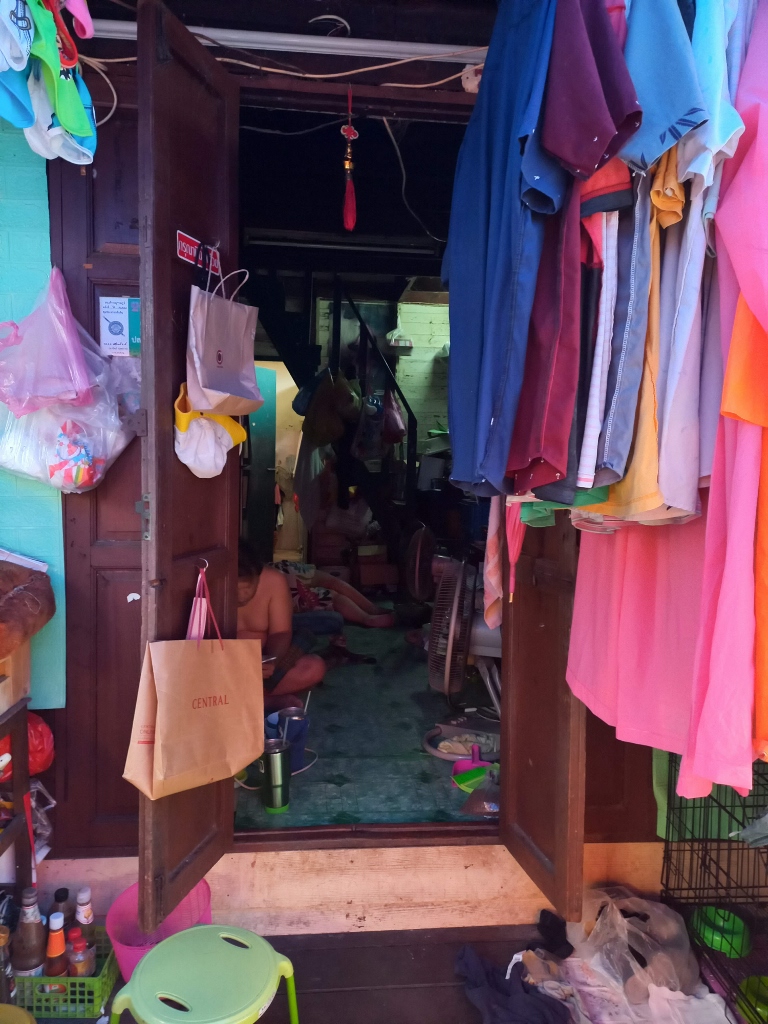 Bangkok, a detail
Bangkok, a detail
And then at the end of a lane, I spotted one of the larger streets and there I was quite close to my destination – the Wat Suthat temple.
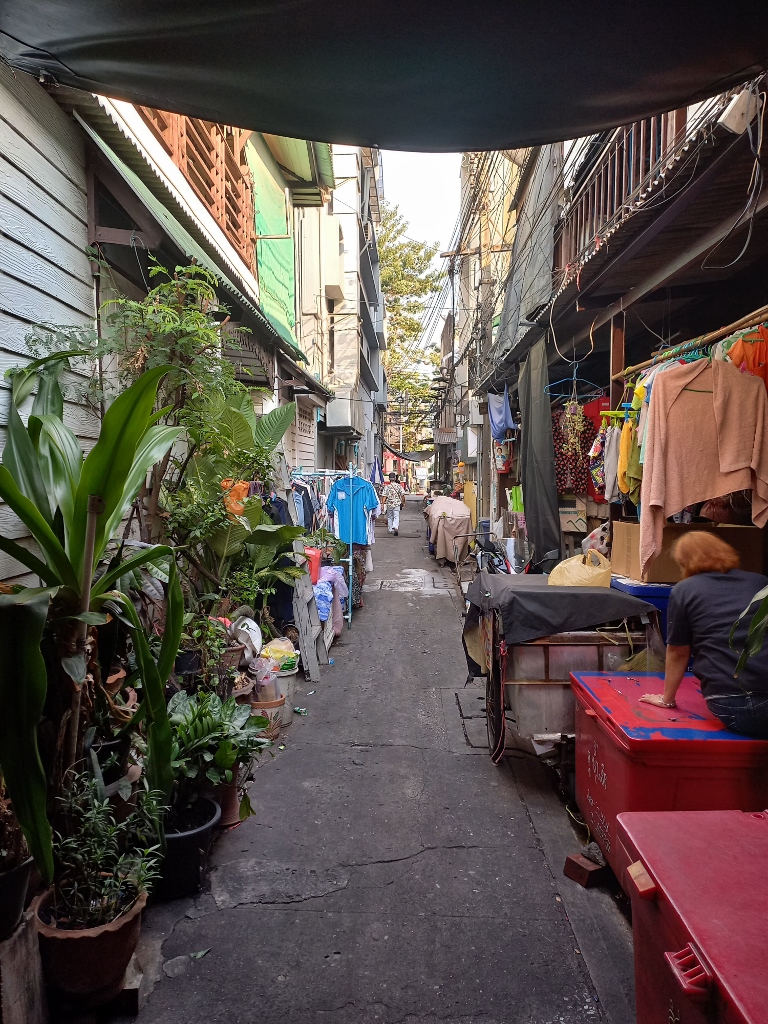 Bangkok, a detail
Bangkok, a detail
 Square in front of the Wat Suthat temple
Square in front of the Wat Suthat temple
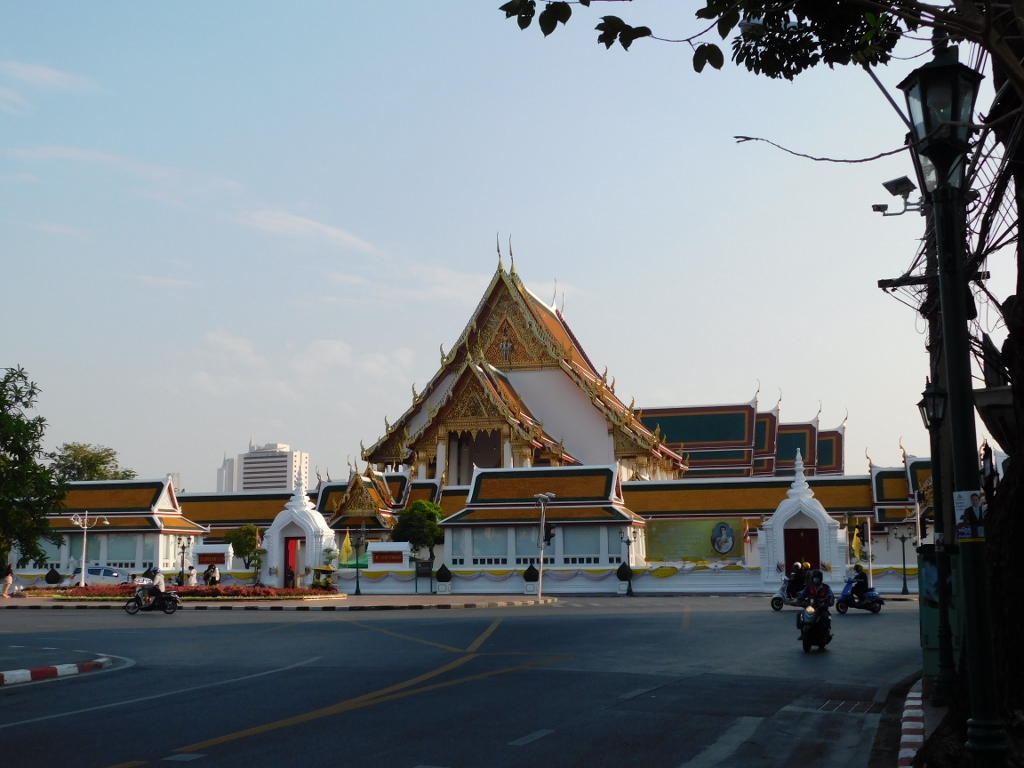 Entrance into the Wat Suthat temple
Entrance into the Wat Suthat temple
The Wat Suthat temple was founded in 1807 by King Rama I, although the construction of the temple was completed during the reign of King Rama III in 1847/48. At the time of its founding, the temple’s location was in the heart of the capital city, while today it is one of the first grade royal temples. In front of the temple, there is the Giant Swing, which refers to a specific religious structure used in an ancient ceremony that has long been discontinued, serving as a tourist attraction today. It is a tall wooden structure painted in red, visible in the panoramic photograph I shared above.
At this temple, King Rama I envisioned the big vihara, the main hall, modelled after a famous vihara from Ayutthaya. However, as I’ve said, the construction was completed during the reign of King Rama III when a bronze statue of the Buddha, crafted in the Sukhothai style, was brought from Sukhothai and placed in the vihara of this temple.
The Wat Suthat temple is renowned for its architecture, grandeur and artistic forms, and it holds particular significance for its harmonious layout of the buildings within the temple complex, often referred to as the “cosmic layout.” The vihara and the ubosot (the main praying room) play a special role in reflecting this cosmic arrangement. The ubosot at Wat Suthat is considered the largest, longest and most beautiful in Thailand.
Upon entering the temple complex, the first structure you come across is the vihara.
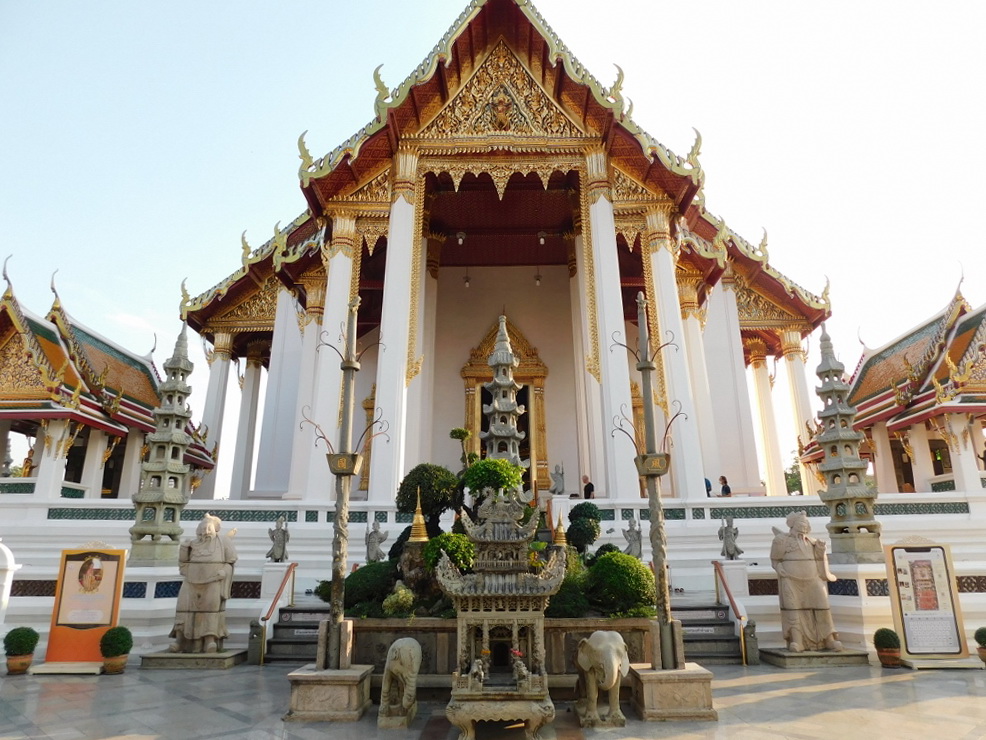 Wat Suthat Temple, the vihara
Wat Suthat Temple, the vihara
Although the vihara appeared truly spectacular, I decided to explore the gallery surrounding the quadrangular courtyard first. The gallery is renowned for its 156 Buddha statues that can be seen here.
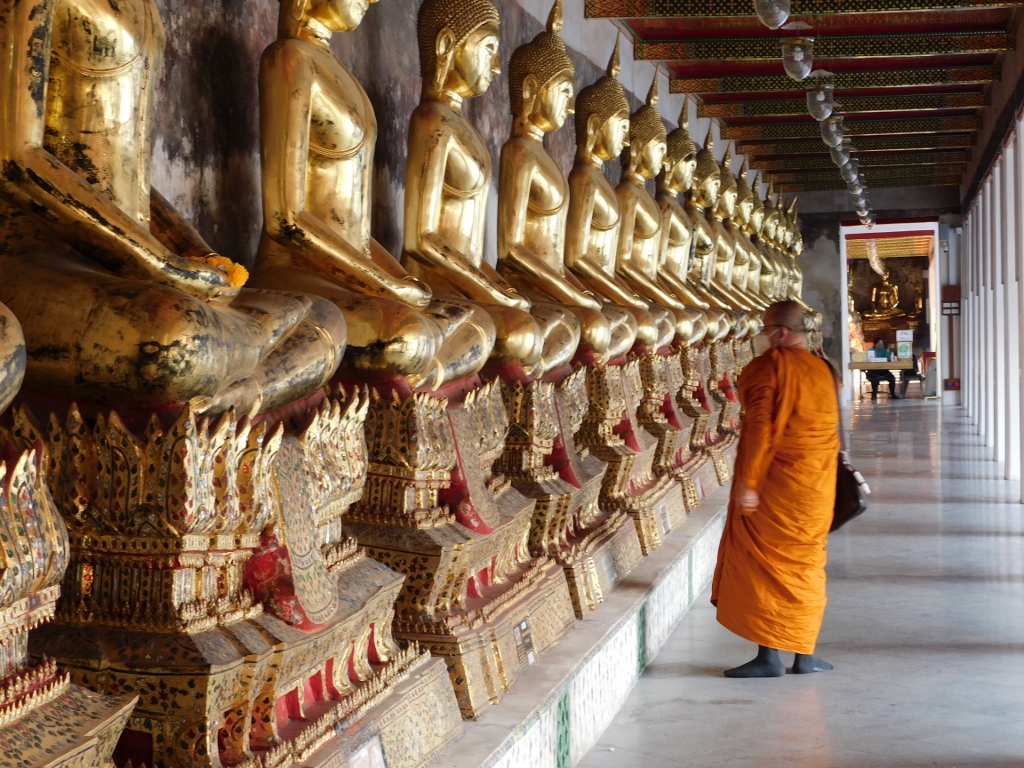 Wat Suthat Temple, the gallery, a detail
Wat Suthat Temple, the gallery, a detail
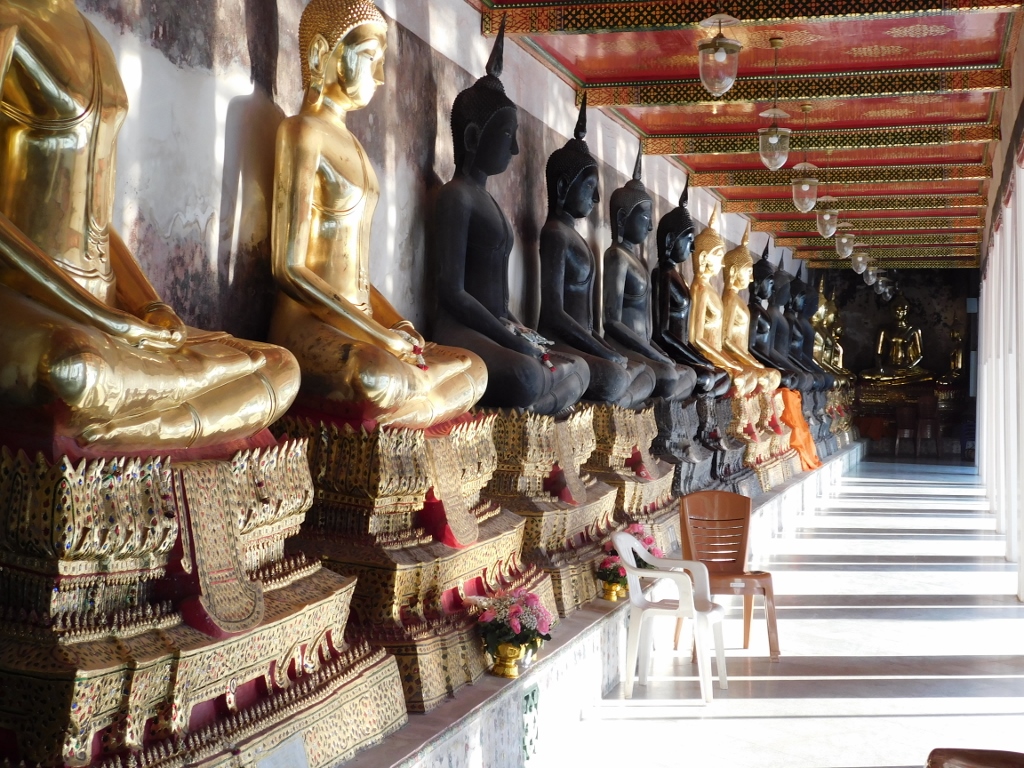 Wat Suthat Temple, the gallery, a detail
Wat Suthat Temple, the gallery, a detail
Above the gallery, a traditional roof adorned with beautiful decorations was crafted and everything looked truly exquisite.
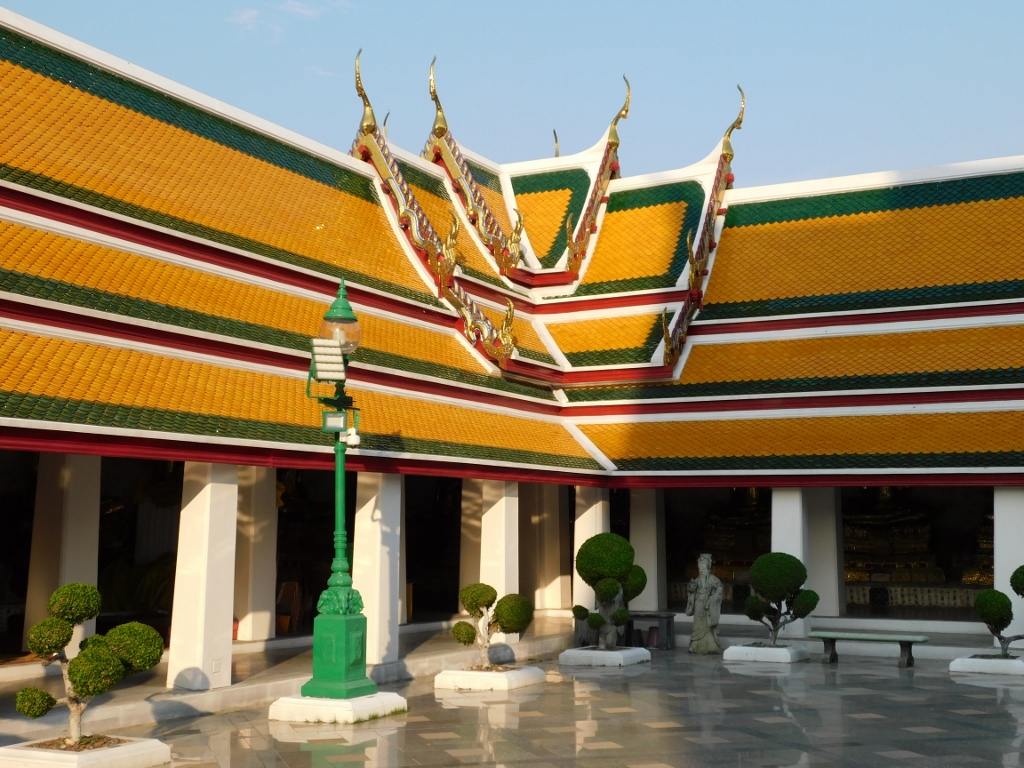 Wat Suthat Temple, the gallery, a detail
Wat Suthat Temple, the gallery, a detail
The vihara itself looked magnificent from the gallery’s direction, but I still stuck to my plan to save the vihara visit for the very end. Now, I just strolled around it, observing and capturing various details. I also paid attention to the roof of the ubosot located in the adjacent part of the temple complex.
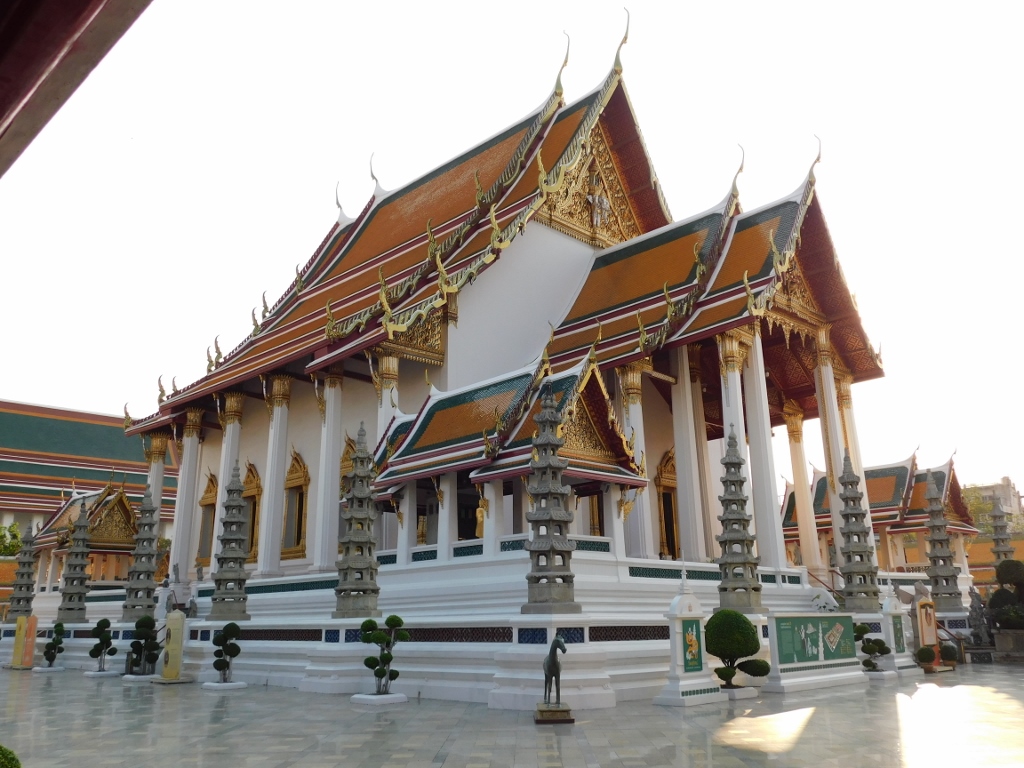 Wat Suthat Temple, the vihara
Wat Suthat Temple, the vihara
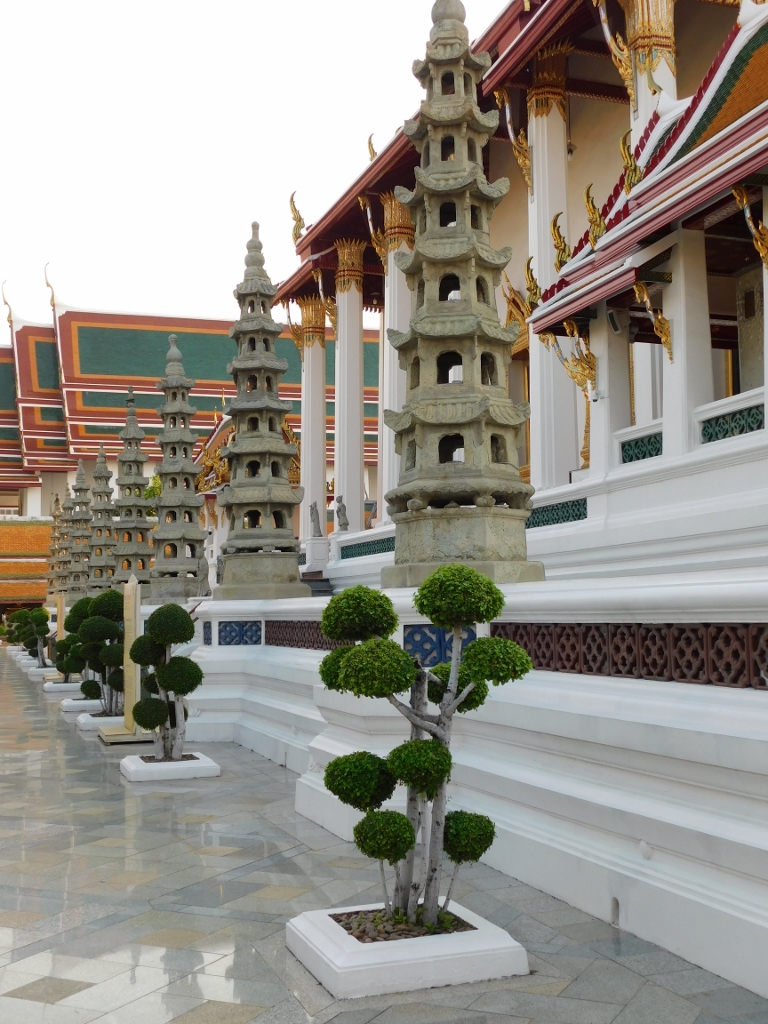 Wat Suthat Temple, details of the vihara and the courtyard around it, as well as the roof of the ubosot a little farther away
Wat Suthat Temple, details of the vihara and the courtyard around it, as well as the roof of the ubosot a little farther away
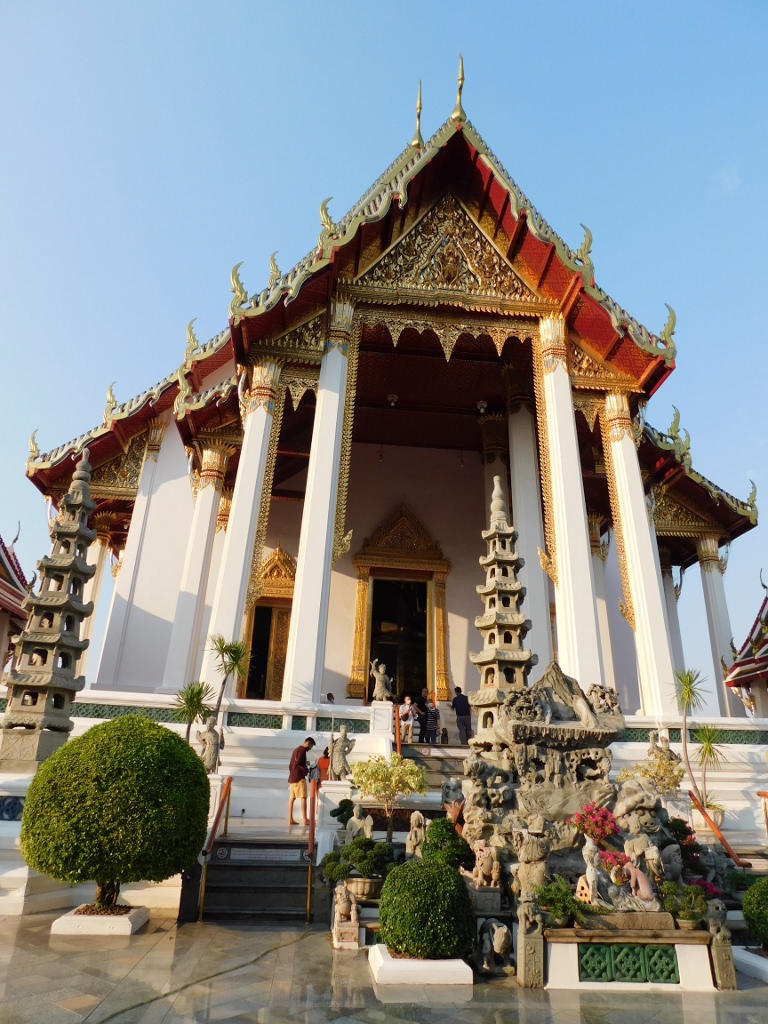 Wat Suthat Temple, the vihara
Wat Suthat Temple, the vihara
From the paved courtyard around the vihara, you pass through one gate to enter another courtyard where the ubosot is located.
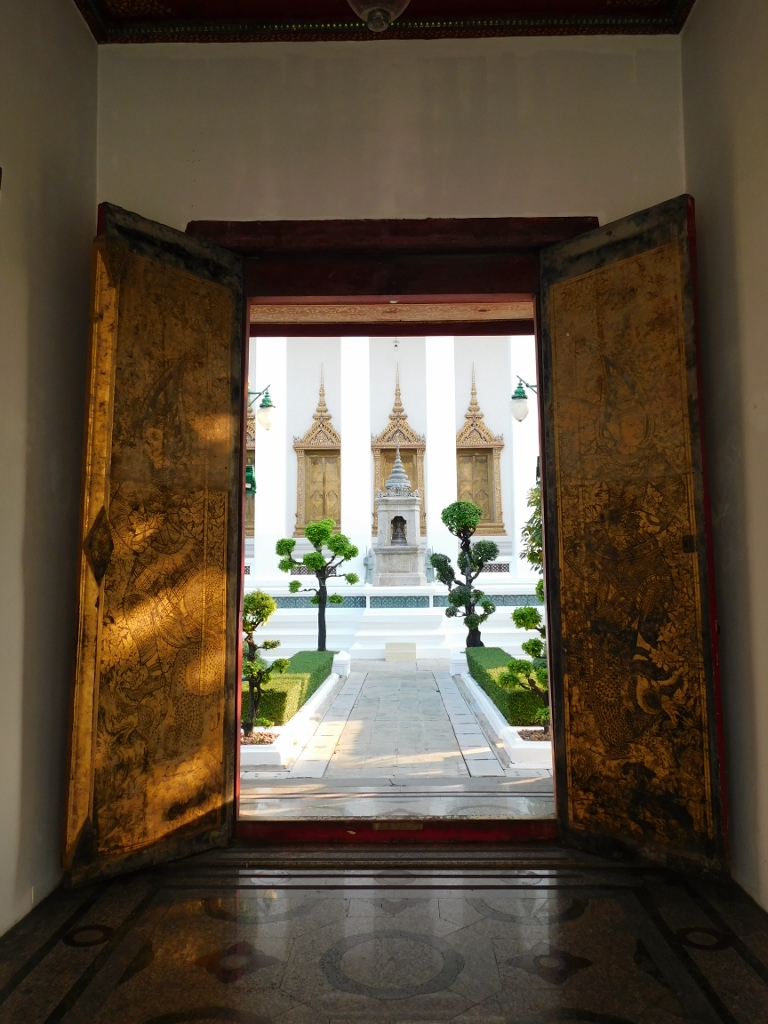 Wat Suthat Temple, gate leading to the ubosot
Wat Suthat Temple, gate leading to the ubosot
The ubosot of Wat Suthat Temple is truly grand and approaching it like this makes it challenging to grasp its entirety.
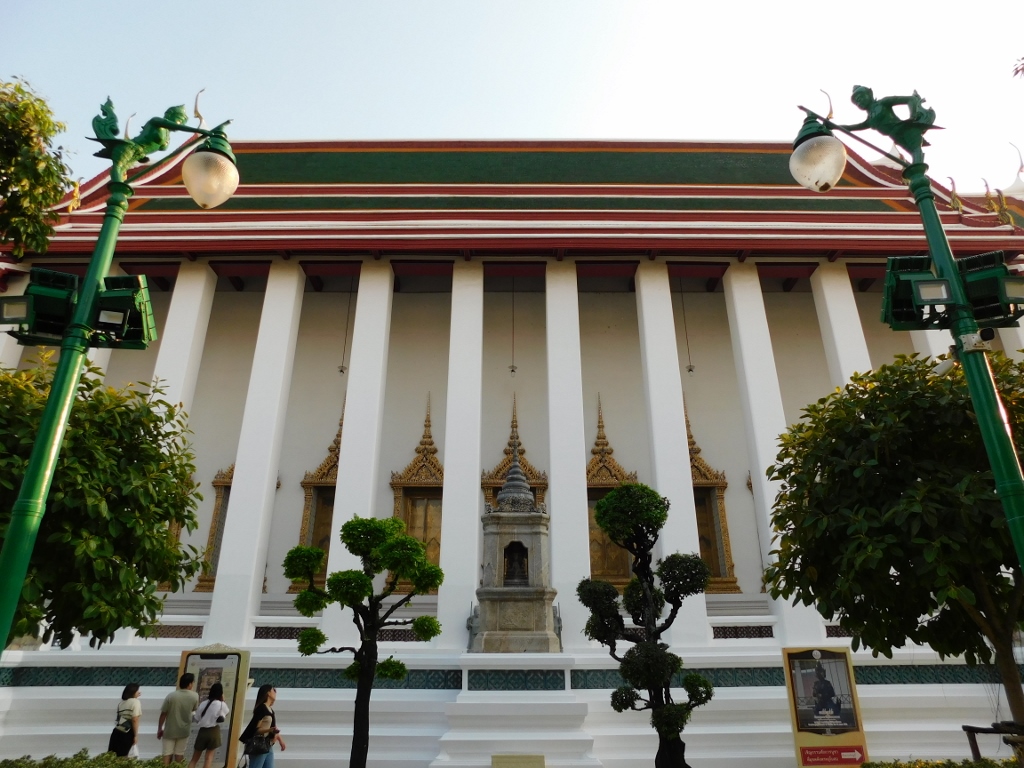 Wat Suthat Temple, the ubosot
Wat Suthat Temple, the ubosot
The ubosot was also built in the first half of the 19th century when the influence of Westerners was already making its mark in this part of Asia. This influence didn’t bypass the “guardians” of the ubosot – some of them exhibit clear Western attributes, personally reminding me of the comic character Corto Maltese. On the other hand, throughout the entire complex, including the ubosot itself, numerous sculptures and objects suggest a Chinese influence.
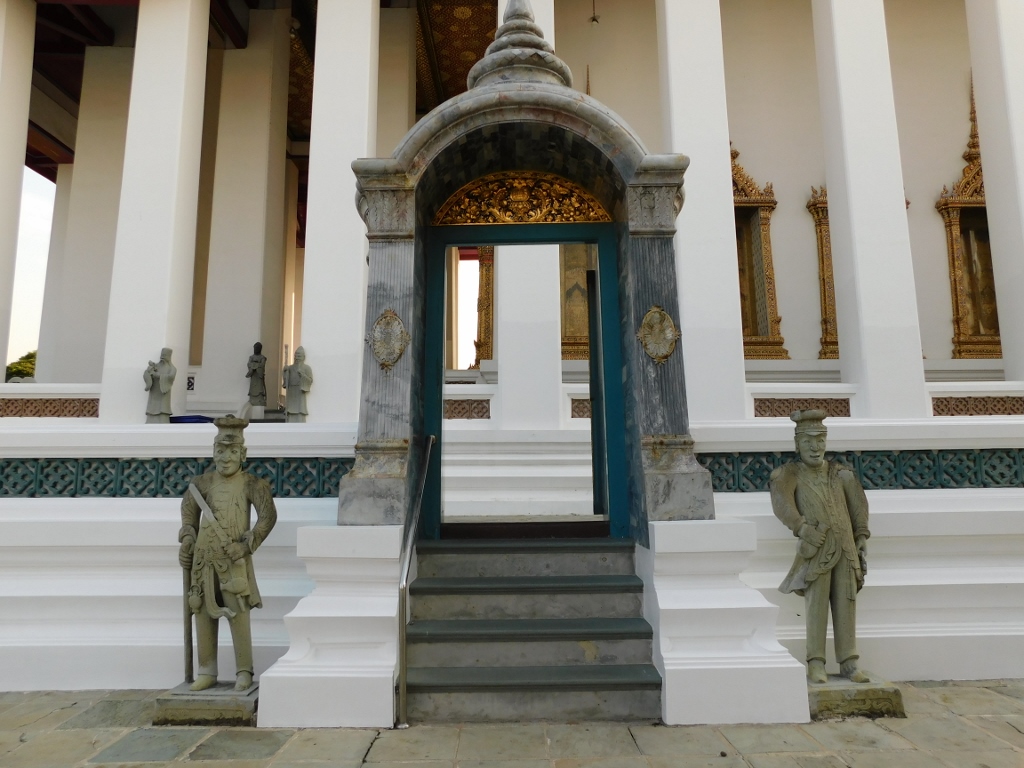 Wat Suthat Temple, the ubosot, a detail
Wat Suthat Temple, the ubosot, a detail
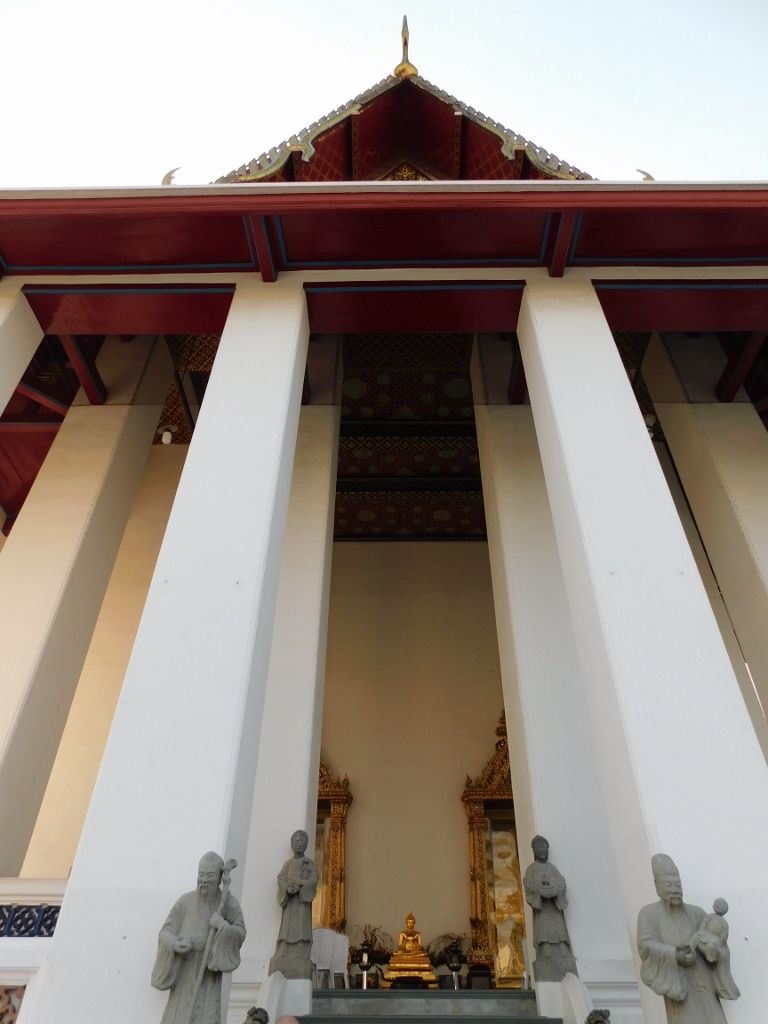 Wat Suthat Temple, the ubosot, a detail
Wat Suthat Temple, the ubosot, a detail
When I arrived here, the ubosot was closed to visitors, but on the entrance porch, there is a row of smaller shrines. For me, as a visitor, they were interesting, but for practicing Buddhists, they serve as places for prayer and offerings.
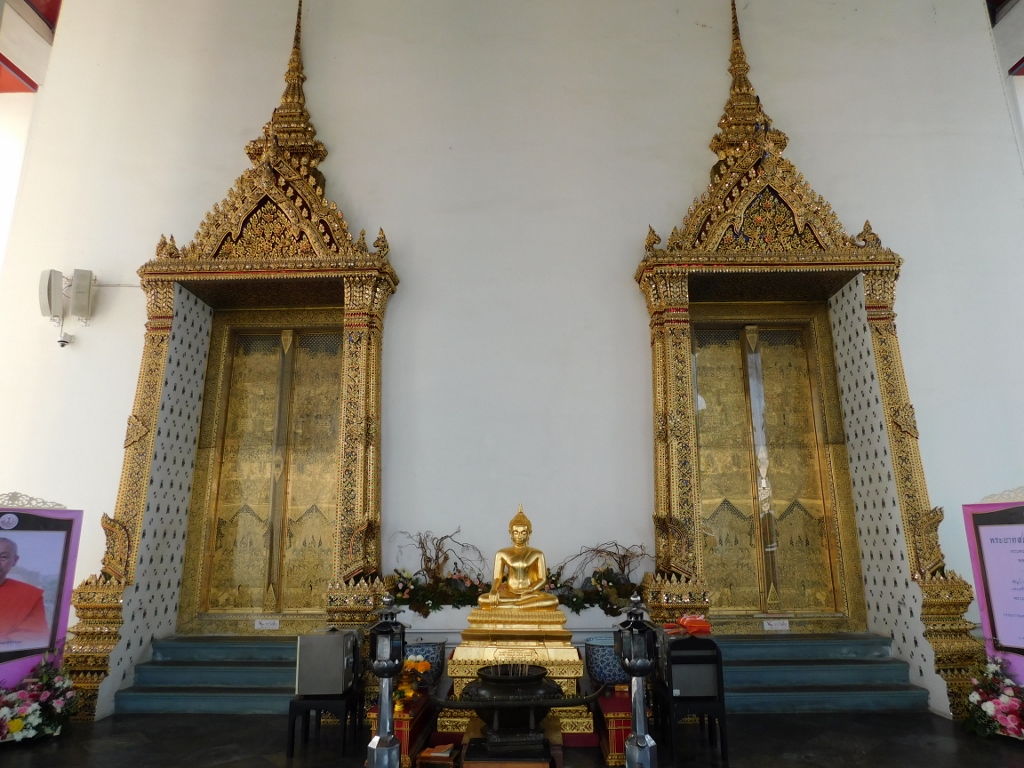 Wat Suthat Temple, the ubosot, a detail
Wat Suthat Temple, the ubosot, a detail
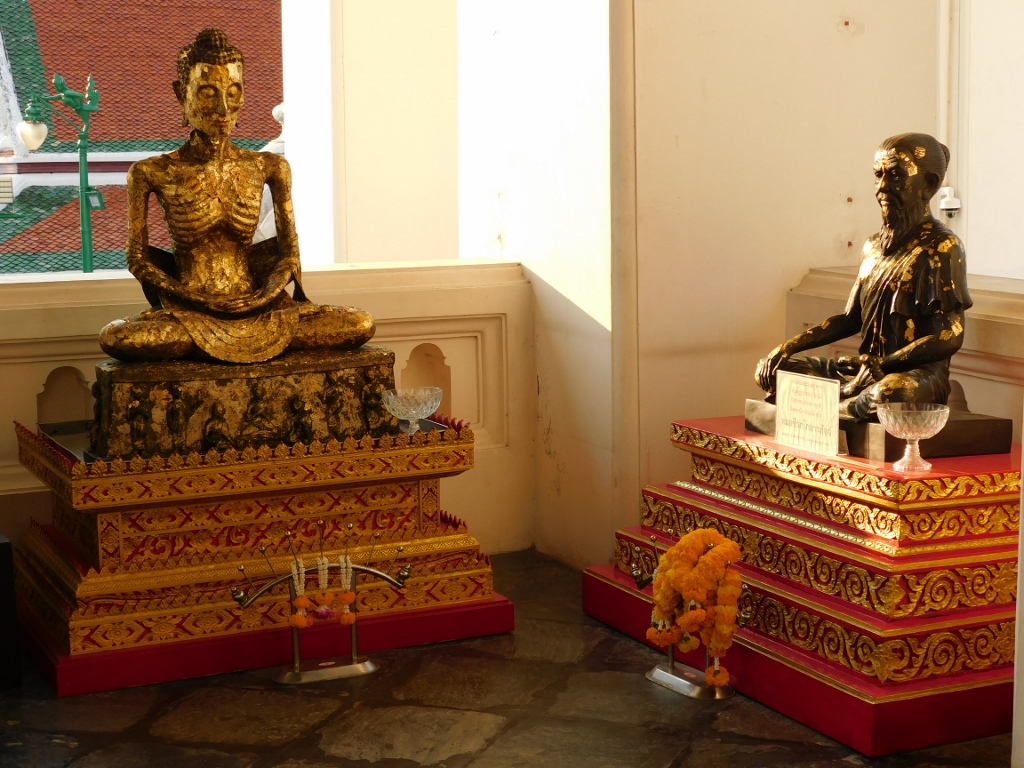 Wat Suthat Temple, the ubosot, a detail
Wat Suthat Temple, the ubosot, a detail
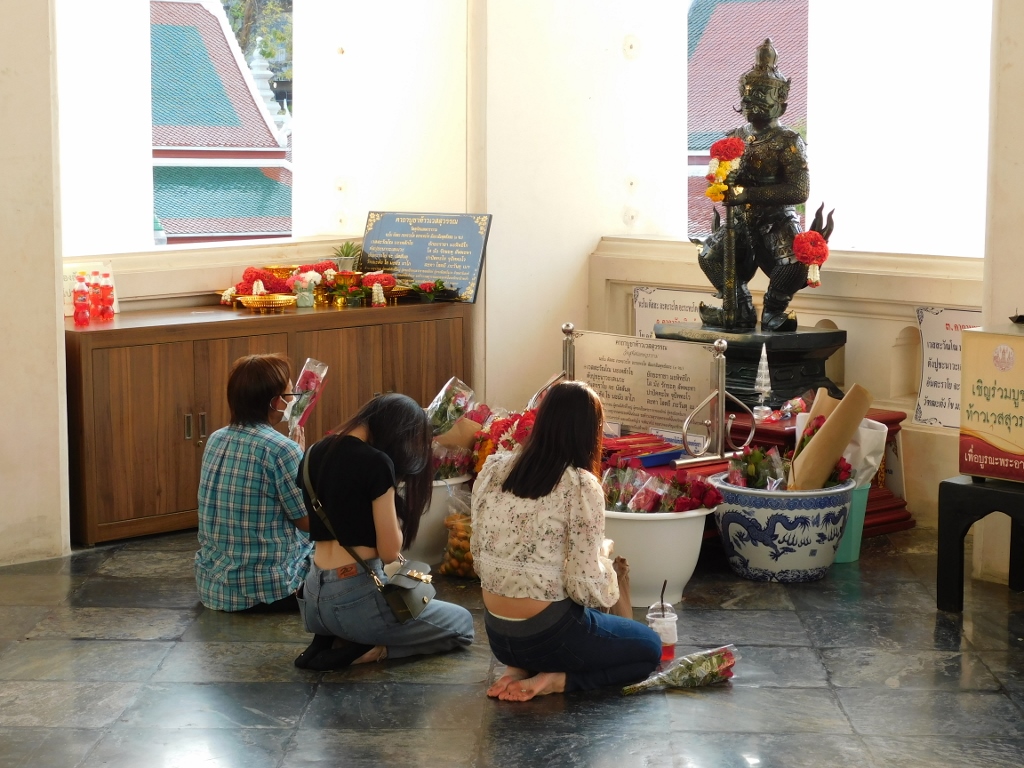 Wat Suthat Temple, the ubosot, a detail
Wat Suthat Temple, the ubosot, a detail
I walked a bit more along the corridor that surrounds the central room of the ubosot and I particularly liked the windows in this area.
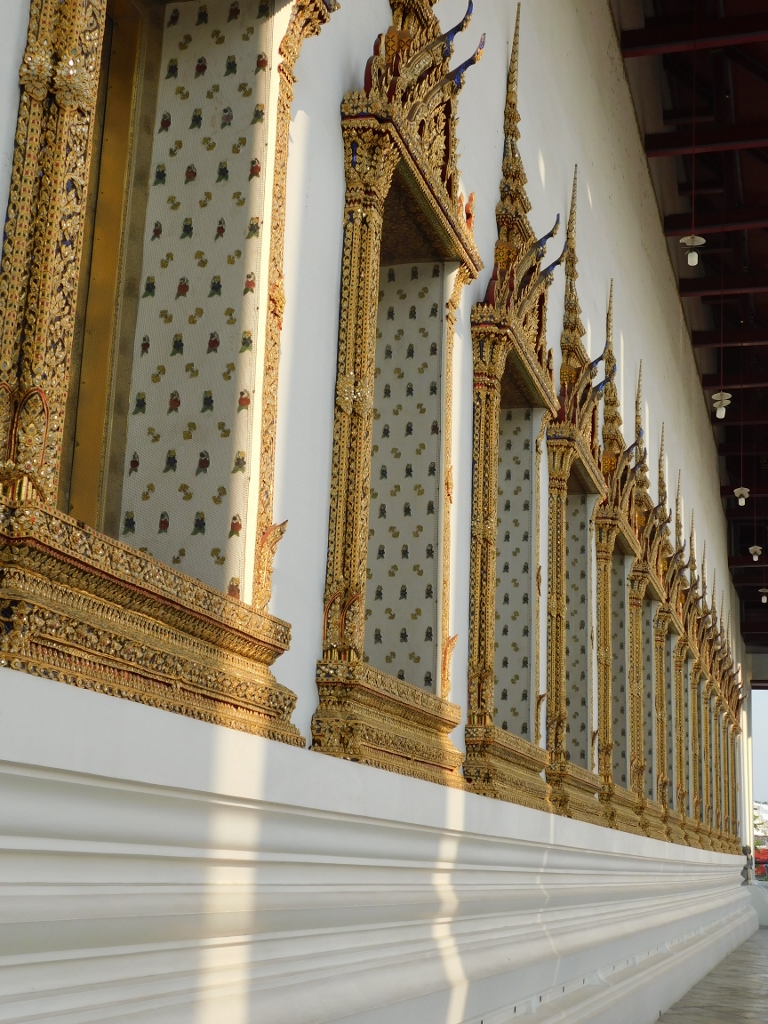 Wat Suthat Temple, the ubosot, a detail
Wat Suthat Temple, the ubosot, a detail
And then I moved to the part of the courtyard behind the ubosot, which offered a wonderful view of this section of the temple.
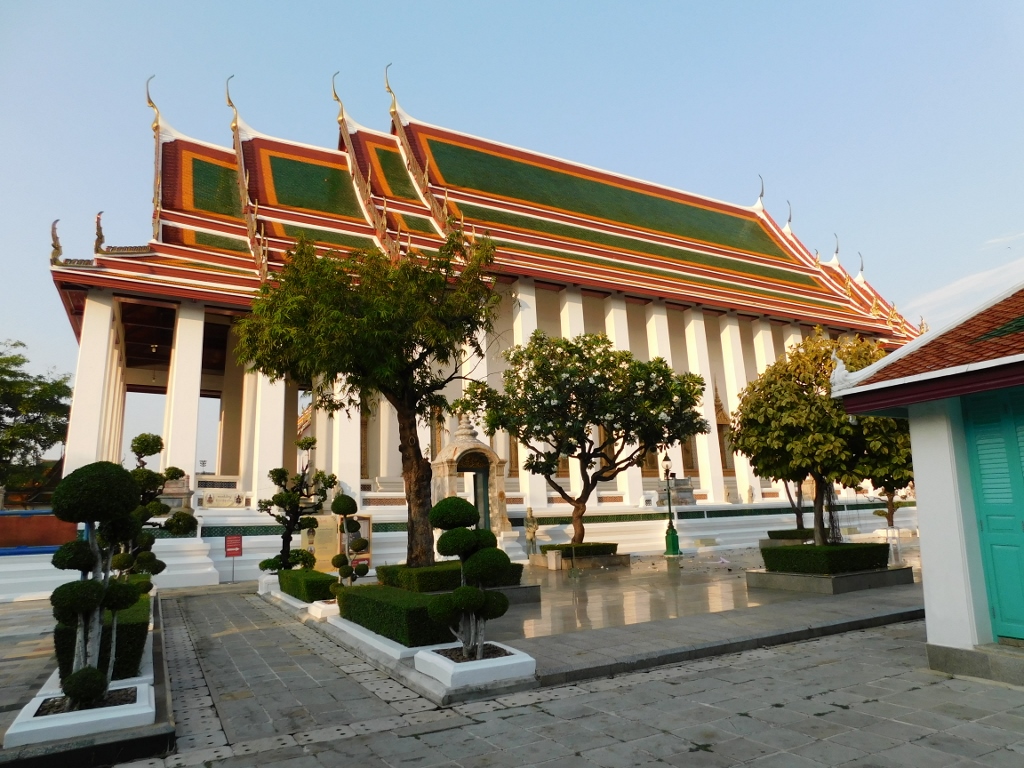 Wat Suthat Temple, the ubosot
Wat Suthat Temple, the ubosot
As for the courtyard around the ubosot, there, of course, as everywhere, a whole multitude of different details can be seen and the visitor can certainly spend hours and hours in the temple if such details interest them. Here, I first paid attention to, perhaps, a mundane detail, such as a part of the lamp post in the form of elephants. Still, it was a picturesque detail.
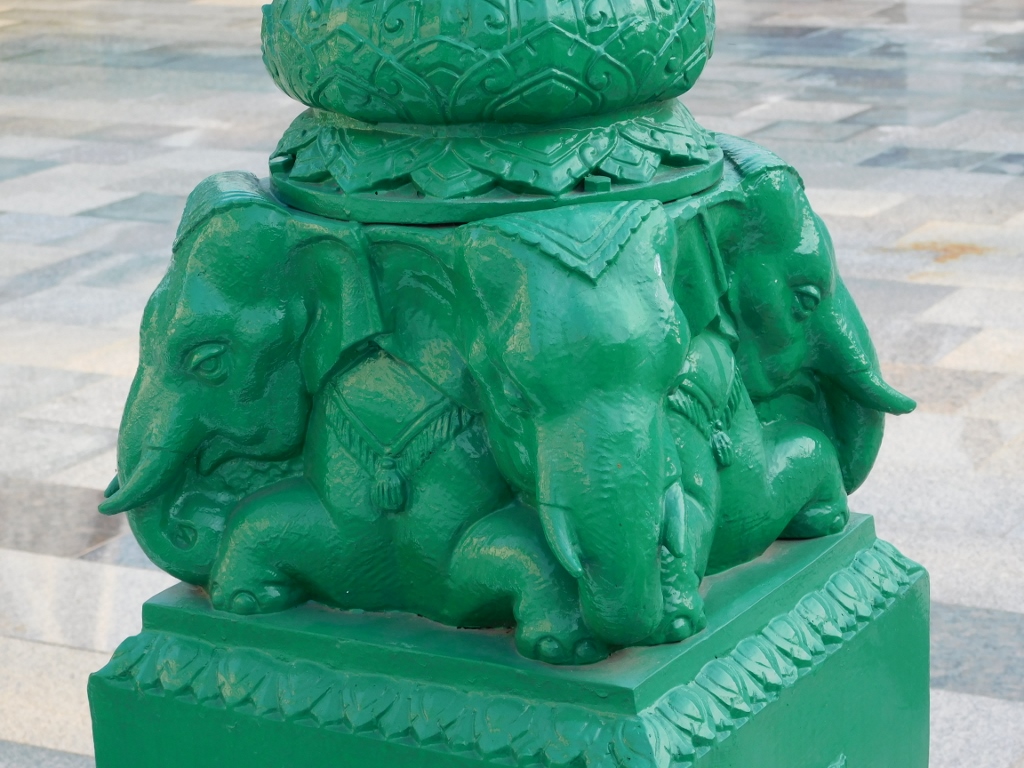 Wat Suthat Temple, a detail
Wat Suthat Temple, a detail
Also within this courtyard, there is a lawn and here I noticed a monk engrossed in reading.
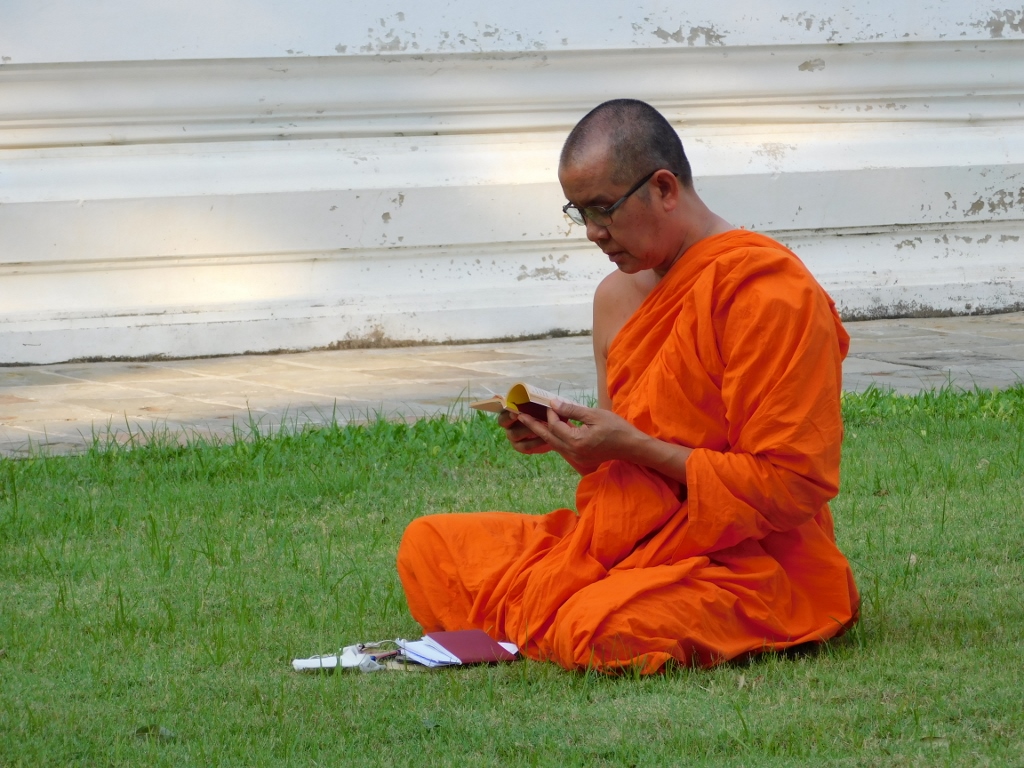 Wat Suthat Temple, a detail
Wat Suthat Temple, a detail